Jasper has been one of the most popular AI writing tools since before the rise of ChatGPT.
While it remains a strong option, there are plenty of reasons you might consider a Jasper alternative in 2025: its high price, the emergence of tools better suited to specific content marketing needs, or output that falls short of your editorial standards.
As a content writer with over four years in the marketing industry, I’ve worked extensively with Jasper alongside numerous other AI writing tools.
This article is an hands-on review of the 13 best Jasper alternatives, highlighting their strengths, weaknesses, and ideal use cases so you can choose the right fit for your content strategy.
What is Jasper?
Jasper is an AI-powered writing assistant designed to help marketing teams create various content assets, including blog posts, email newsletters, ad copy, and eBooks.
Launched in 2021 (originally as “Jarvis”), Jasper runs on GPT-4 alongside other large language models, enabling it to interpret prompts and produce coherent, high-quality drafts.
In addition to text generation, Jasper offers Jasper Art for AI-generated images, SEO workflows for content optimization, and integrations with tools like Grammarly, Google Docs, and Surfer SEO.
Key strengths of Jasper include:
- Brand voice setting – Lets you define and apply a consistent tone of voice so your content feels on-brand and human.
- Extensive templates – Dozens of ready-made formats for blog post intros, product descriptions, LinkedIn bios, and more.
- Beginner-friendly interface – Clean layout with intuitive templates and “recipes” that speed up the learning curve.
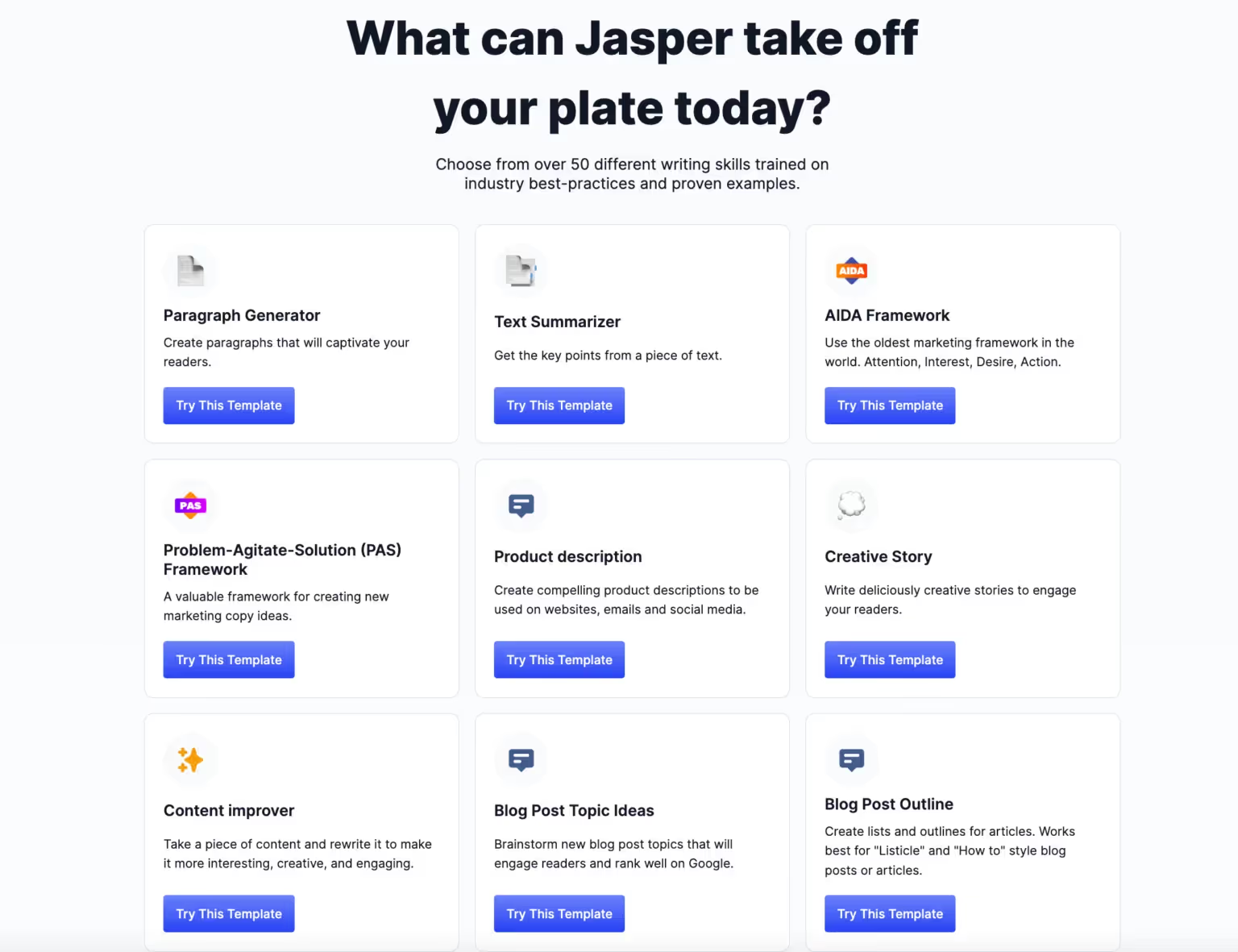
Jasper also supports over 25 languages and includes a built-in grammar and plagiarism checker.
Why consider Jasper alternatives?
Jasper has earned its place as a capable writing tool, but it isn’t perfect. Its higher price point can be a challenge for content teams that publish at scale, particularly when equally powerful tools are available for less.

The platform also leans heavily on well-crafted prompts, a skill that takes time to develop, which means results can be inconsistent, especially for newer users.
While Jasper’s long-form assistant is a standout feature, it’s less effective for short, high-impact copy like ad headlines or social media posts, and it can fall short on complex, technical topics.
The lack of robust integrations also means more manual work to move content into tools like WordPress, Zapier, or other publishing platforms.
For marketers who need specialized capabilities — such as SEO-optimized briefs, multilingual output, or bulk e-commerce descriptions — a different AI writing tool might be a better match.
1. Surfer
Surfer is a full-scale content creation and optimization platform built for teams who want their content to rank and keep ranking — without sacrificing speed, versatility, or quality.
While Jasper focuses primarily on generating copy in various formats, Surfer combines those same multi-channel writing capabilities with data-backed SEO guidance, real-time optimization, and ongoing performance tracking.
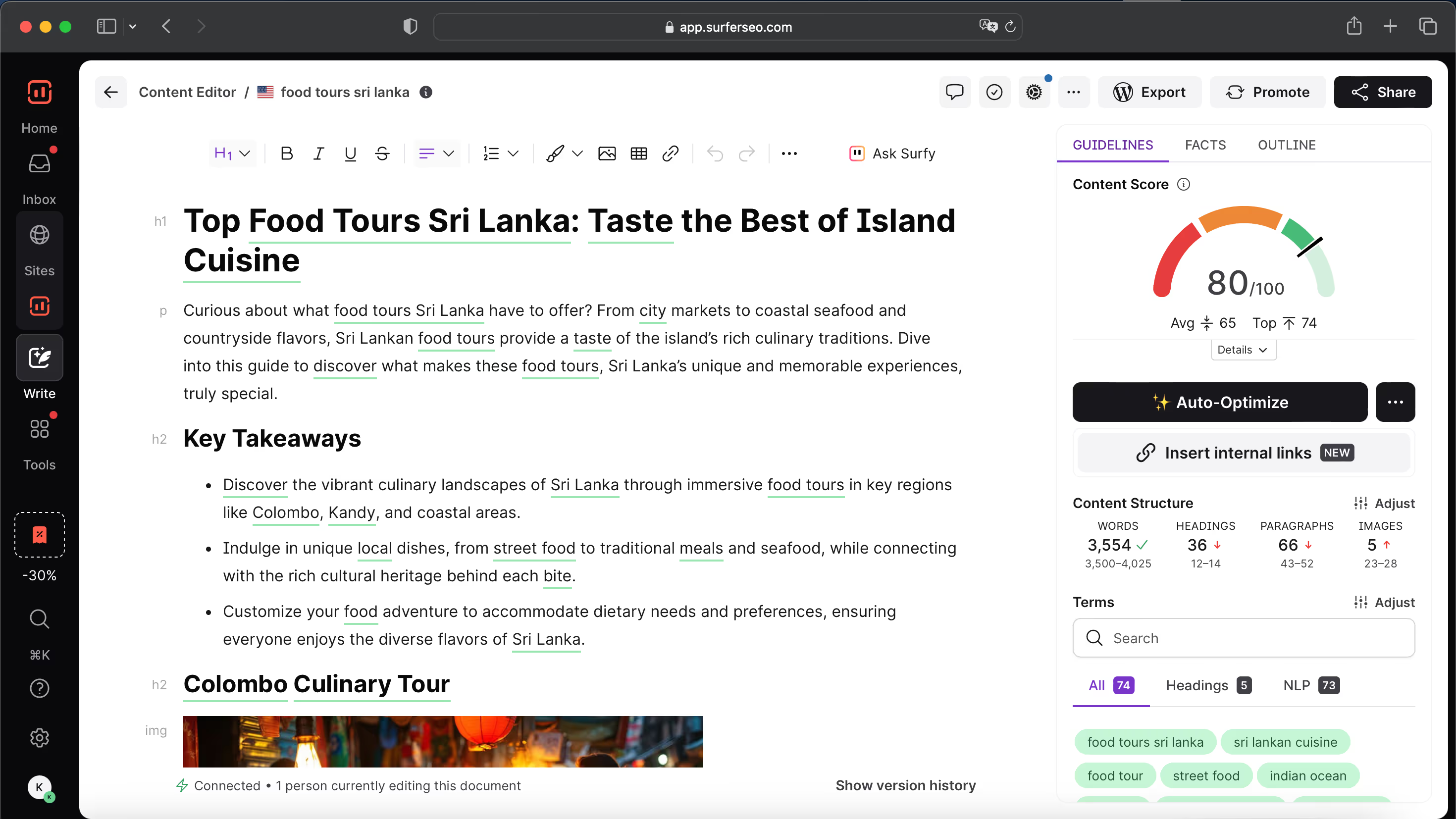
Main features:
- Content Editor with live scoring – Offers real-time keyword, structure, and topical coverage guidance. The Content Score has a 0.28 correlation with Google rankings, giving you a performance-driven target instead of a vague quality metric.
- Auto-Optimize & Coverage Booster – Quickly fill content gaps, insert missing terms, and ensure your article covers all relevant subtopics.
- Surfy (AI assistant) – Rephrase text, adapt tone to match your brand voice, and repurpose blog content into other formats like social posts or email copy.
- Surfer AI – Generate a fully optimized article from scratch, combining AI speed with SEO best practices.
- Multi-language support – Write in any language, with full optimization capabilities for global content strategies.
- Internal linking suggestions – Strengthen site structure with one-click suggestions powered by Google Search Console data.
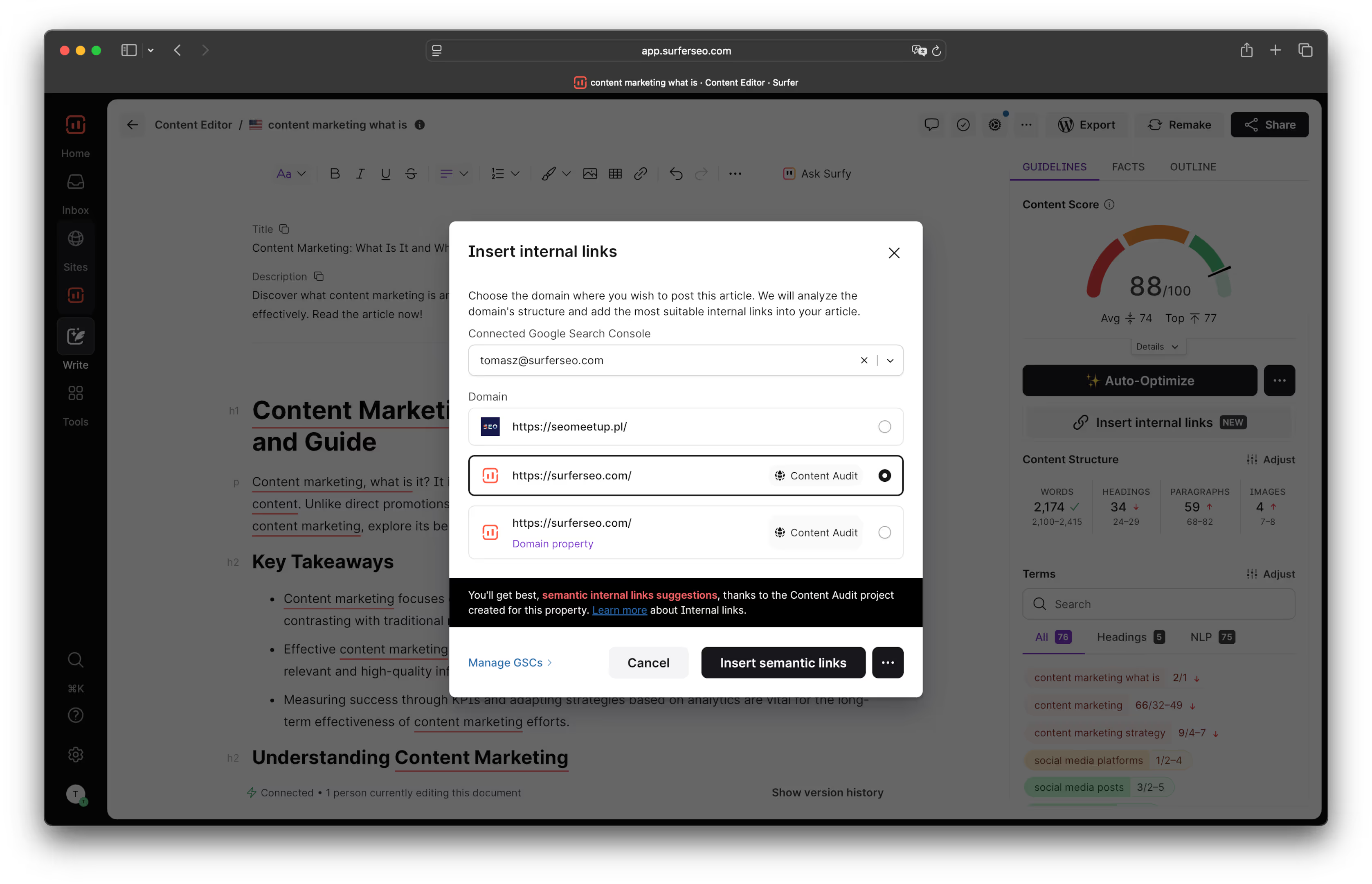
Where Jasper’s core strength lies in generating a wide range of copy, Surfer’s advantage is in turning that copy into content that performs.
The Content Editor is the heart of the platform, combining live optimization with integrated tools for ideation, keyword research, and topic coverage.
If you hit a wall, features like Auto-Optimize and Coverage Booster can instantly close gaps, and Surfy can help you reshape sections, adjust tone, or turn a blog post into a newsletter, ad, or social update without starting from scratch.
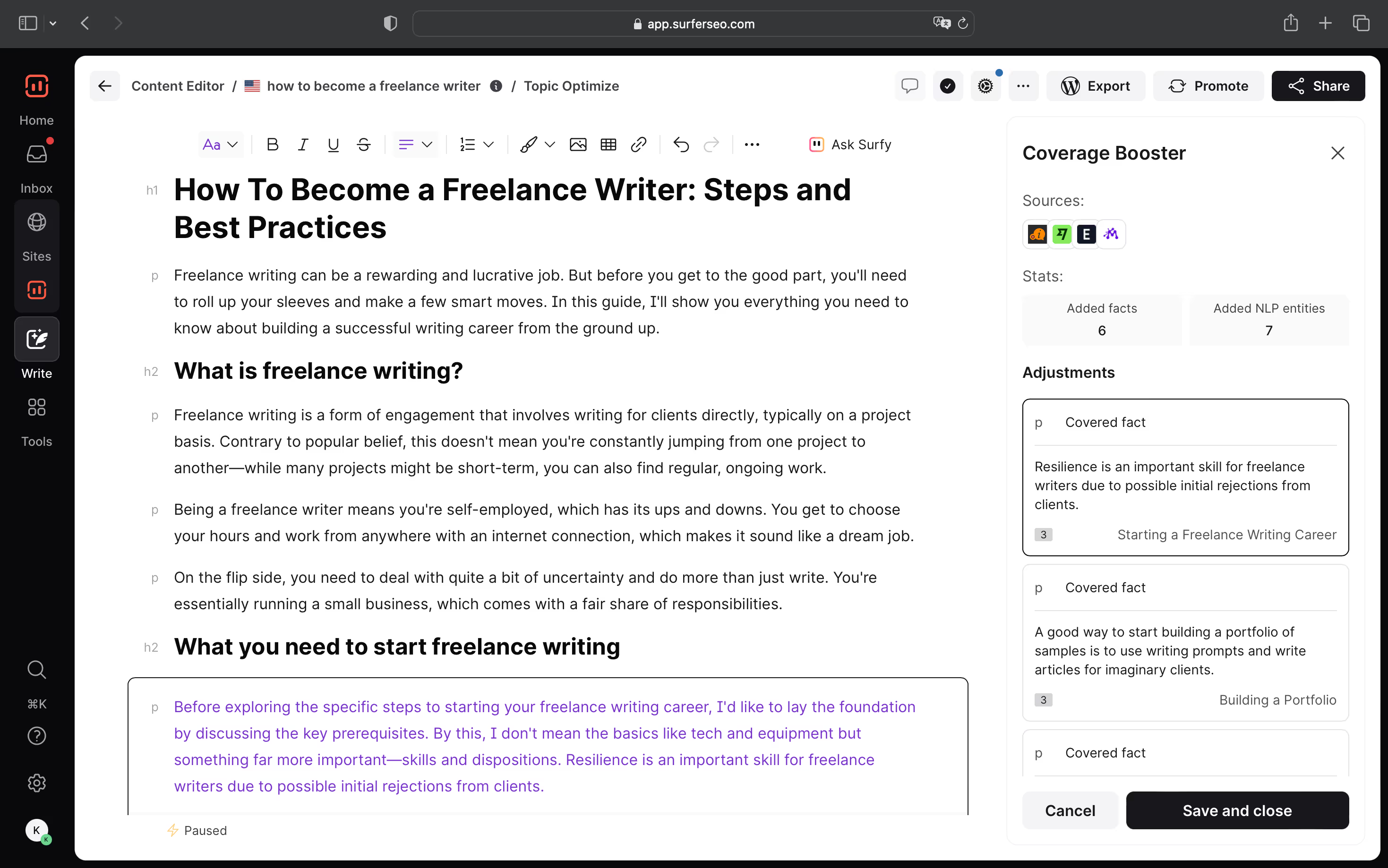
And because Surfer’s features extend beyond writing, you can run Content Audits to revive underperforming pages, map out topic clusters with Topical Maps, and even track your visibility in AI-driven search engines like Google’s AI Overviews and ChatGPT Search with the AI Tracker.
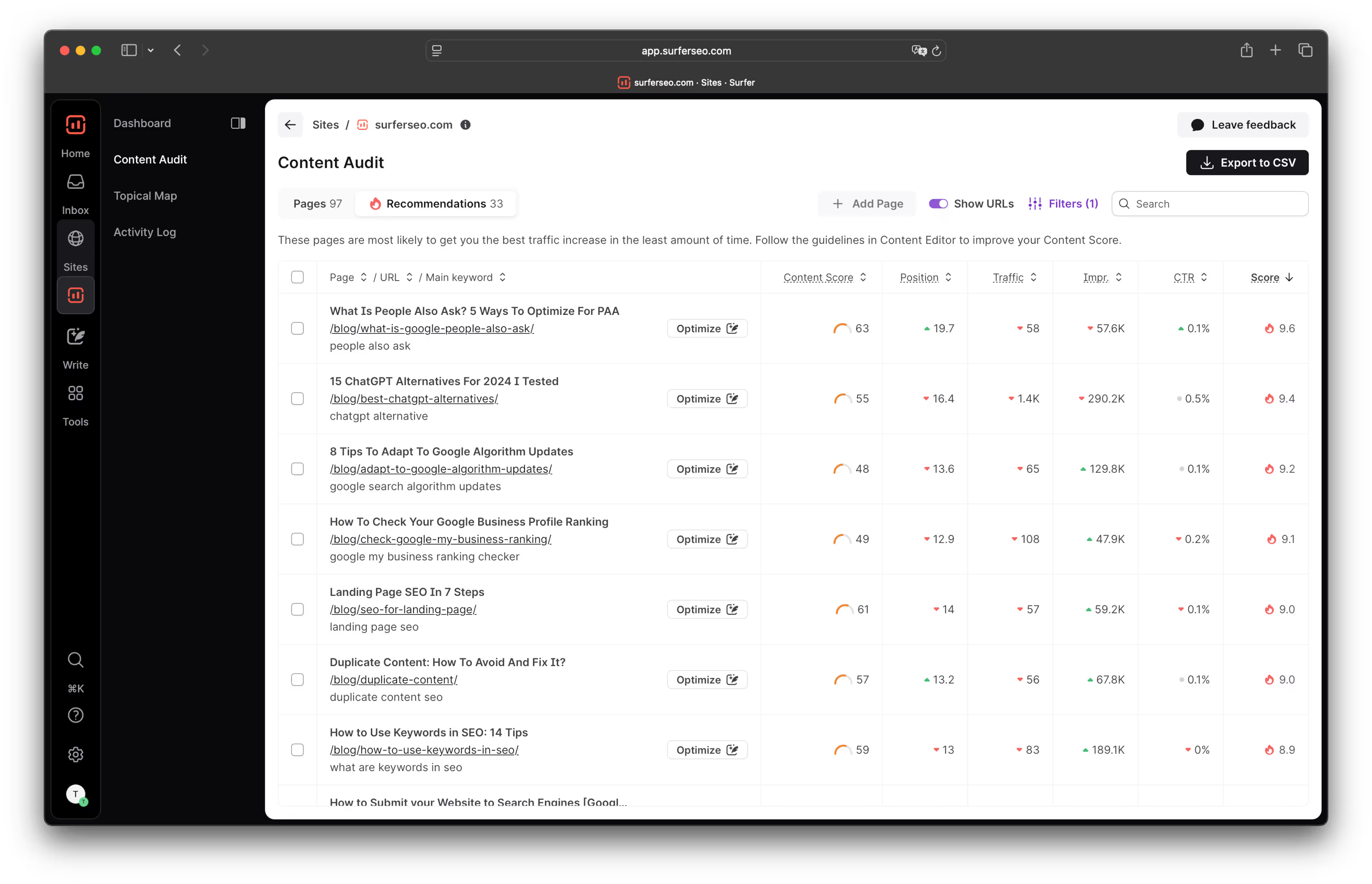
Surfer works for blogs, landing pages, product pages, and more—making it a practical Jasper alternative if you want both creative flexibility and data-backed optimization in one place.
Surfer’s biggest strength is how it connects strategy, creation, and optimization in one place. You can plan a content hub, create a fully optimized article with live feedback, repurpose it for other channels, and monitor its performance over time—all without juggling multiple tools.
Best for: Teams who want AI-assisted writing backed by proven SEO data, with the tools to plan, create, and grow rankings over time.
2. Writesonic
Writesonic is a versatile and affordable Jasper alternative, particularly strong for short-form marketing copy.
With a wide range of templates, built-in SEO tools, and even AI-generated images, it’s an appealing option for marketers who want multiple features in one platform without a high price tag.
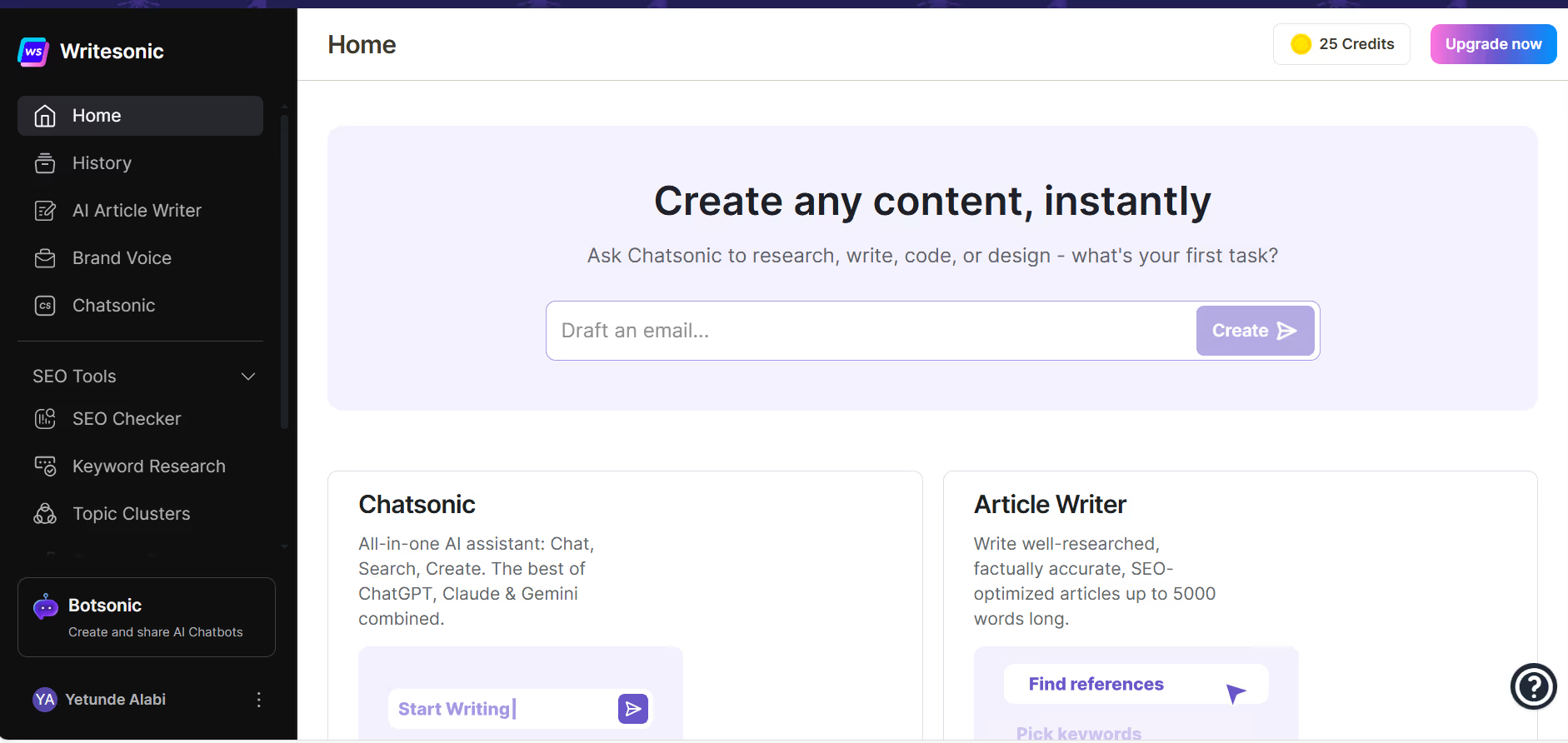
Main features:
- 50+ content templates – Covering blog posts, email sequences, press releases, ads, and social captions.
- Brand voice cloning – Upload sample text so the AI can match your tone in future outputs.
- Chatsonic – A conversational AI tool that blends capabilities from multiple large language models.
- Built-in SEO tools – Includes an SEO checker, topic clustering, keyword research, and content gap analysis.
- Photosonic AI image generator – Create on-brand visuals alongside your written content.
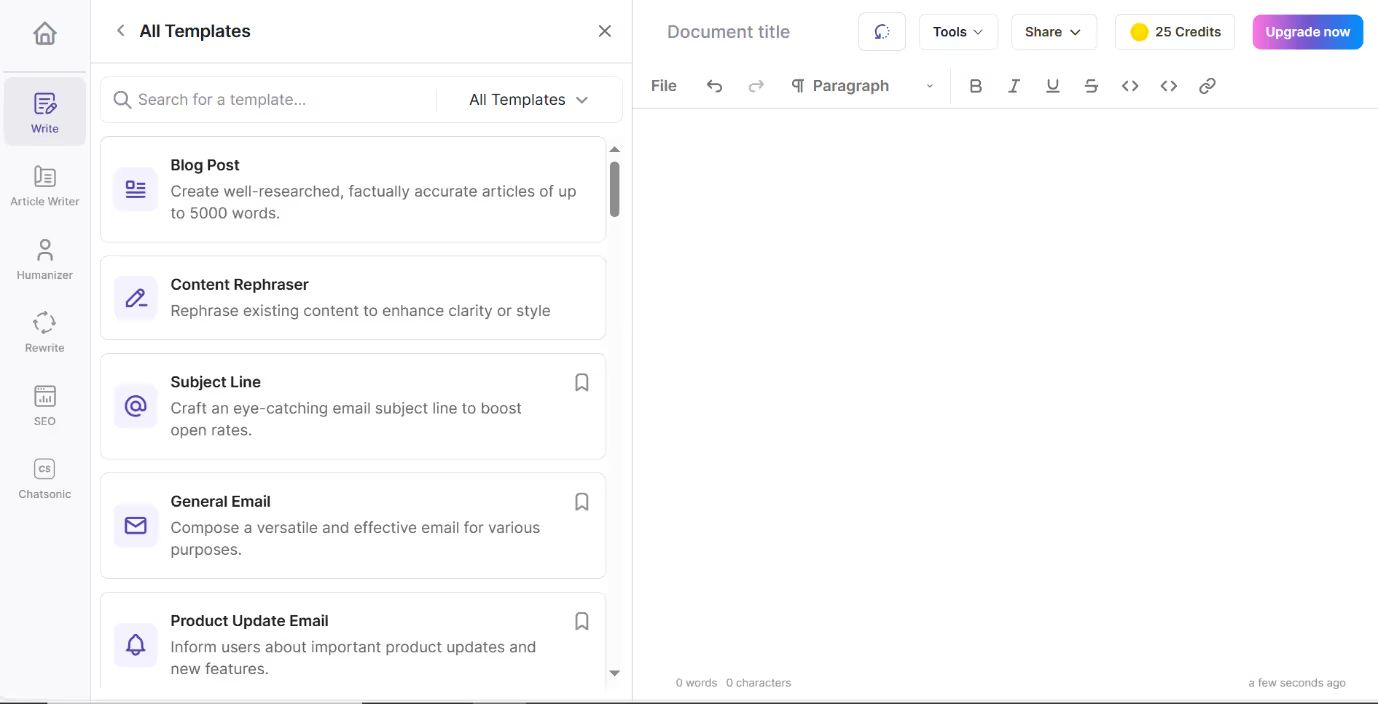
From my experience, Writesonic feels built for marketers who are constantly switching between formats — one moment writing a blog intro, the next creating ad headlines or social captions.
Its SEO tools add real value when you want to tighten up optimization without leaving the platform, and the image generation feature can speed up campaign creation.
However, if you’re producing long-form content regularly and are not satisfied with the quality, consider hiring professional editors like PaperTrue who can ensure a high editorial standard.
You can always go to professional editors like PaperTrue. They make sure that your content is edited to perfection.
Best for: Marketers and content teams who need quick-turnaround copy across multiple formats, with SEO and visual creation tools built into the same workflow.
3. Copy AI
Copy AI is a reliable Jasper alternative that’s great for beating writer’s block and getting content ideas flowing quickly.
Built on the same GPT-4 model as Jasper, it has an intuitive interface and enough flexibility to support everything from blog posts to ad copy, making it a good self-starter tool for marketers.
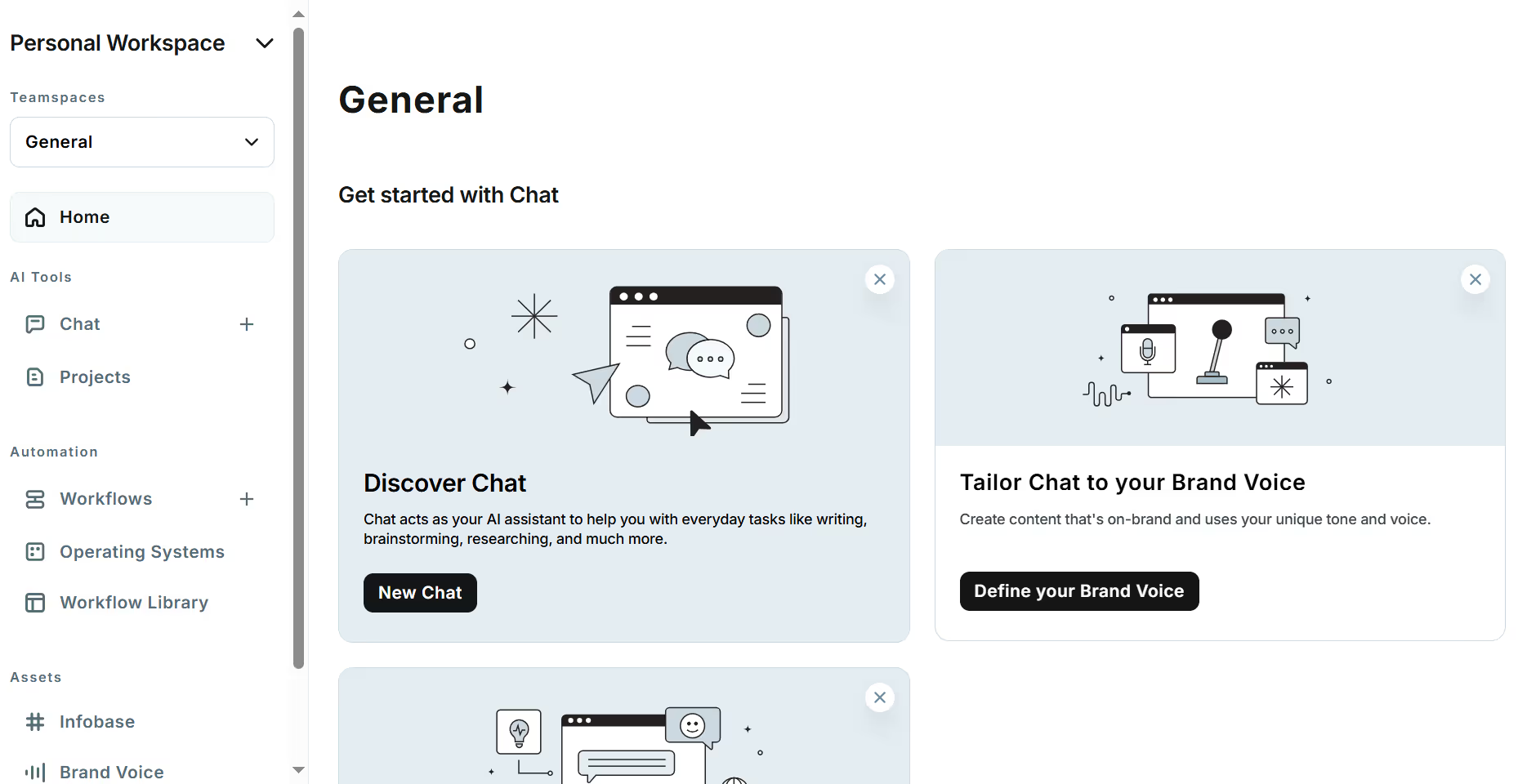
Main features:
- Brand voice – Upload 50–500 words of your own content, and Copy AI will analyze it to replicate your tone in future outputs.
- 90+ templates – A wide range of formats to jumpstart content creation.
- Multi-lingual support – Create content in up to 29 languages for global reach.
- Links to sources – When relevant, the tool can include references so you can verify facts more easily.
- Workflows – Automate processes like lead research or repetitive content generation tasks.
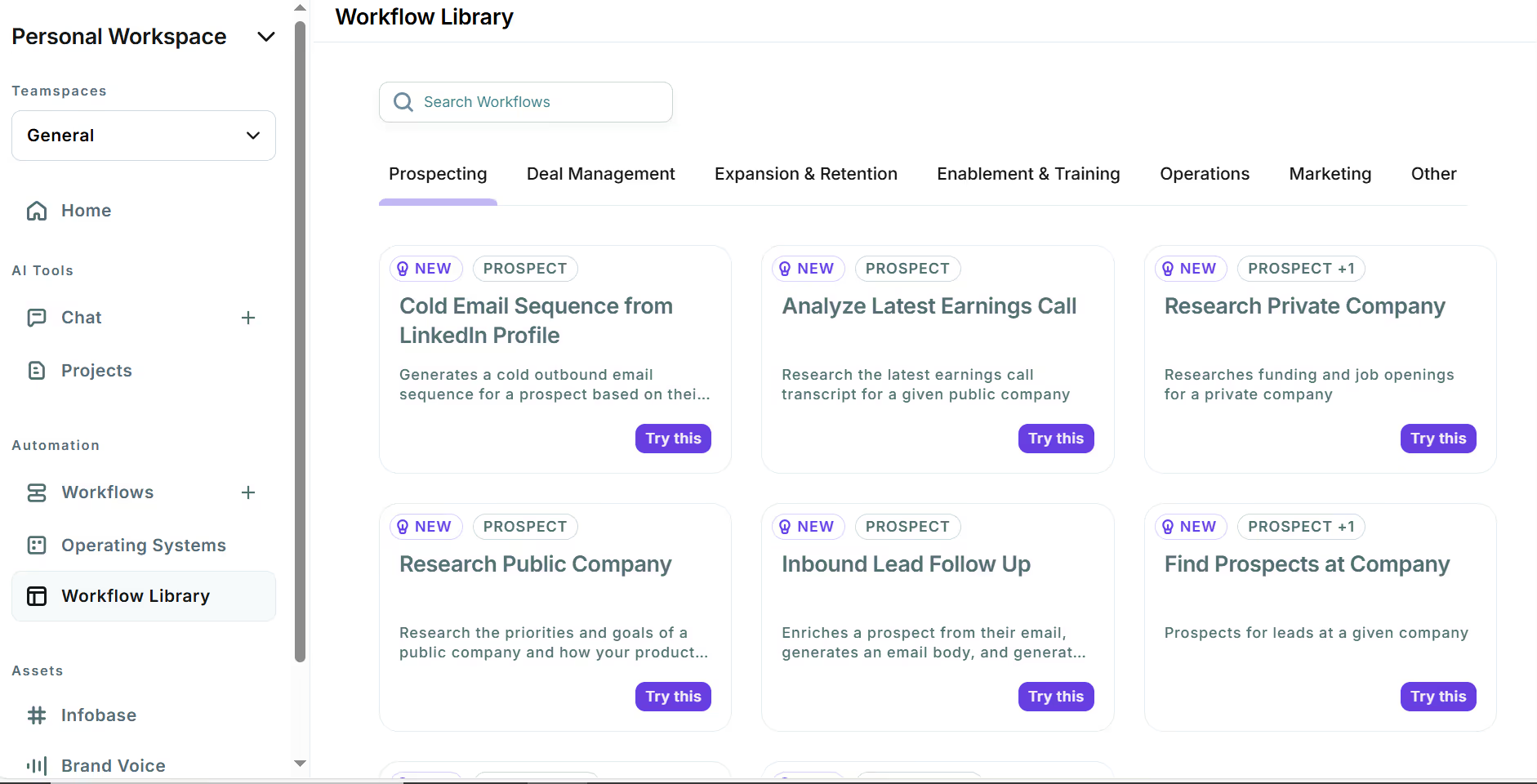
Copy AI is one of the easiest tools to pick up — I rarely feel “stuck” when using it.
The brand voice feature does a decent job at matching tone, and the templates cover a lot of marketing use cases. I especially like the option to include source links, as it saves time on fact-checking.
That said, while the workflow automation is promising, I’ve found it can be hit-or-miss depending on the task; for example, pulling company decision-maker data wasn’t always accurate.
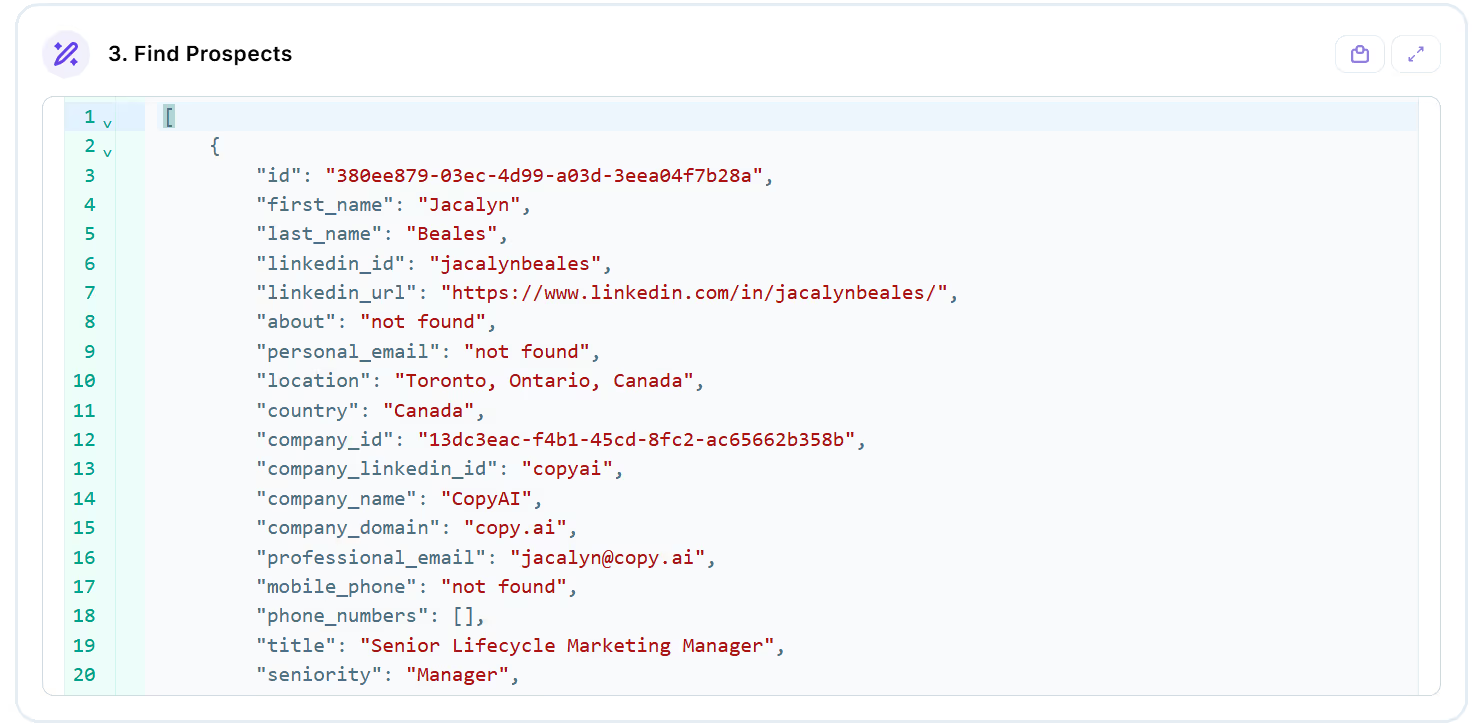
It’s still a strong option if you’re looking for a fast, straightforward content assistant that doesn’t require much setup.
Best for: Marketers who want an easy-to-use AI writer with a wide template library, brand voice matching, and helpful fact-checking support.
4. Rytr
Rytr is a straightforward AI writing assistant that’s especially good for quick, short-form content. Launched in 2021 and built on the GPT-3 model, it’s aimed at helping writers overcome creative blocks without overwhelming them with too many complex features.
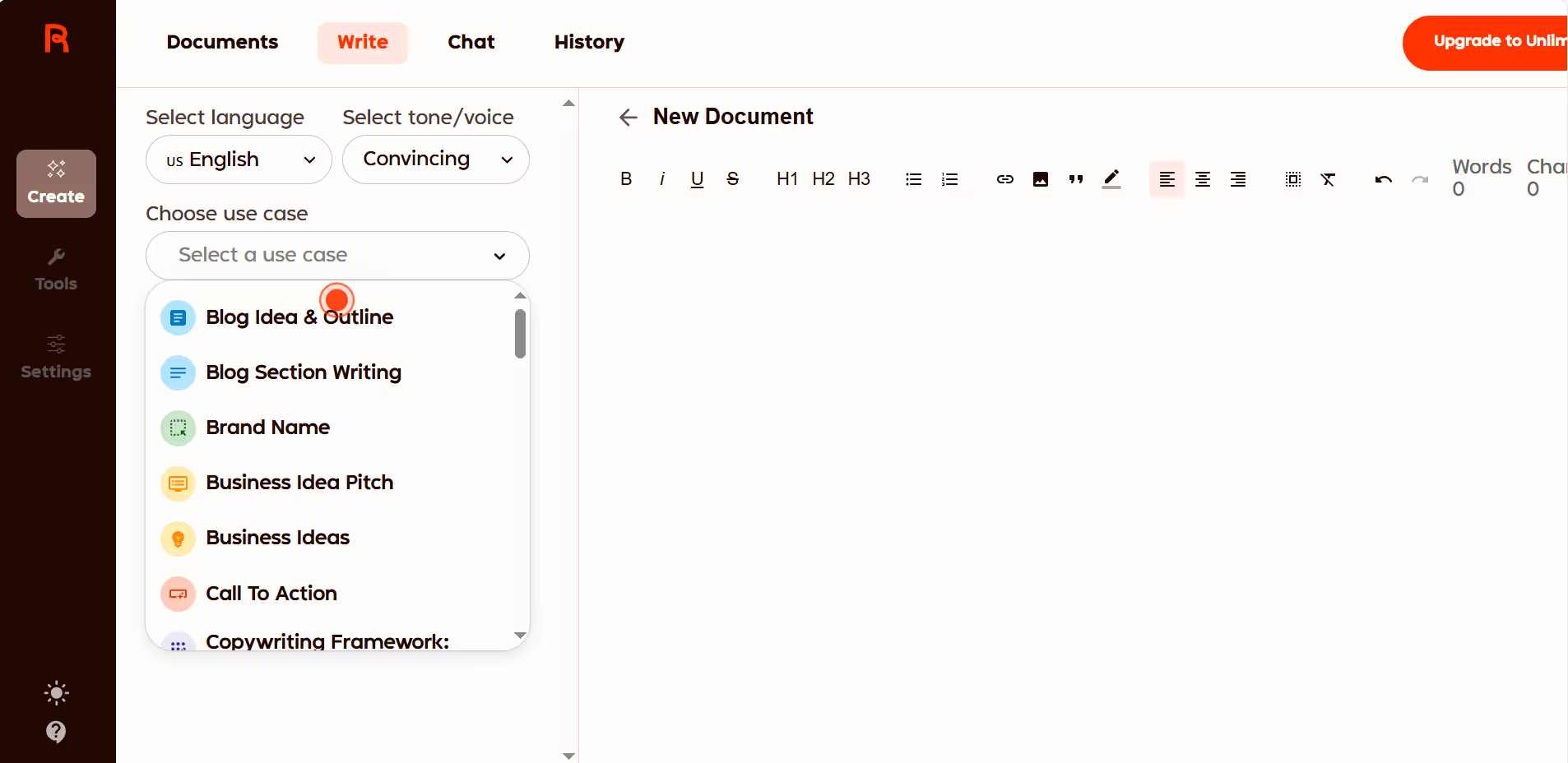
Main features:
- Use cases instead of templates – 40 predefined formats, including popular copywriting frameworks like AIDA (Attention, Interest, Desire, Action) and PAS (Problem, Agitate, Solution).
- Multi-lingual support – Generate content in up to 29 languages, including Hindi.
- Plagiarism checks – With the paid plan, run up to 50 plagiarism checks per month.
- Tone of voice selection – Choose from up to 20 tones or create a custom tone in the paid version.
When I tested Rytr’s PAS framework, the results were fine for getting started, but all three variants opened with the same “evolving digital landscape” type of intro. It’s a dead giveaway that the copy is AI-generated, so I’d still plan on editing heavily before publishing.
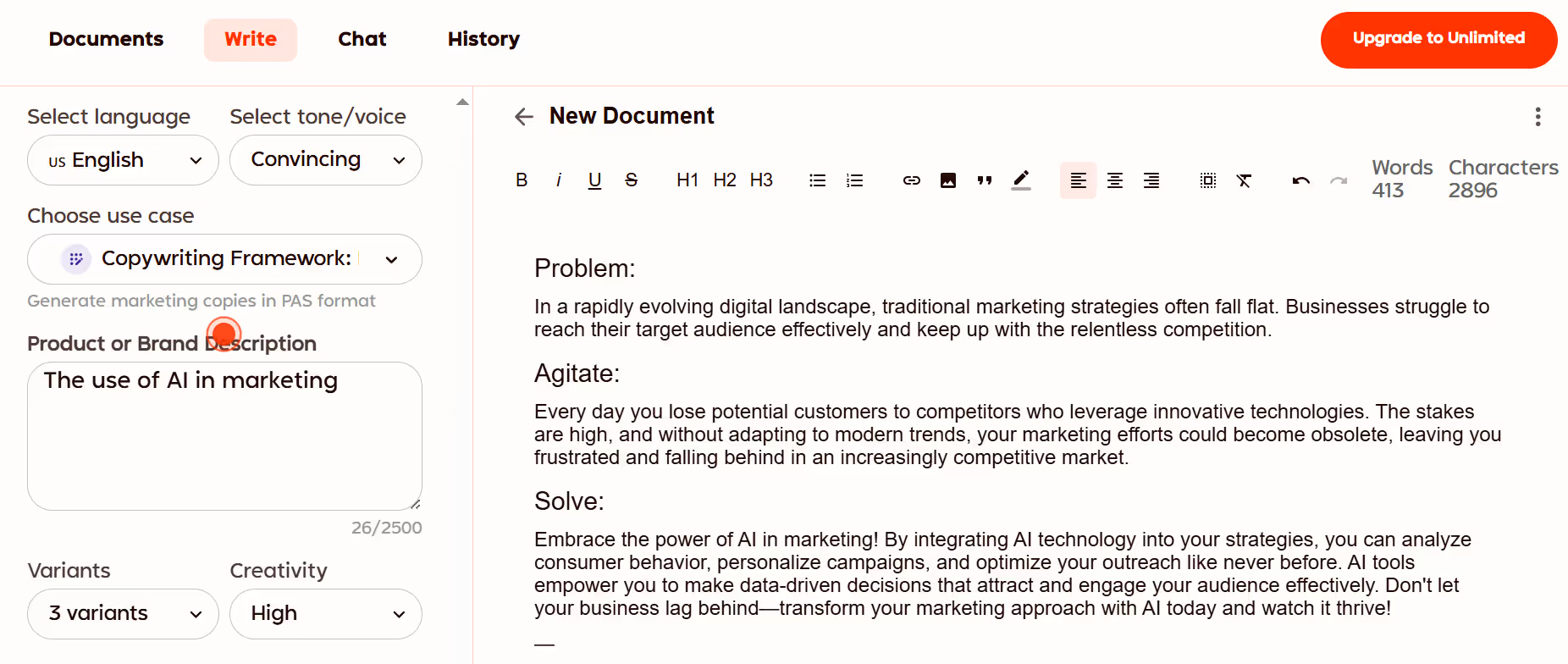
On the plus side, it’s simple to use, and the tone selection is a handy feature when you want to experiment with different styles.
It also offers SERP analysis for certain use cases, giving keyword and ranking insights while you write. However, for long-form SEO-focused content, I’d look elsewhere.
But for quick marketing snippets, it gets the job done if you know how to refine your prompts.
Best for: Writers and marketers who need a simple, affordable tool for short-form copy, especially when following classic copywriting frameworks.
5. Frase
Frase is built to help you plan, optimize, and track search-focused content, making it a solid option for anyone whose strategy depends on ranking in Google.
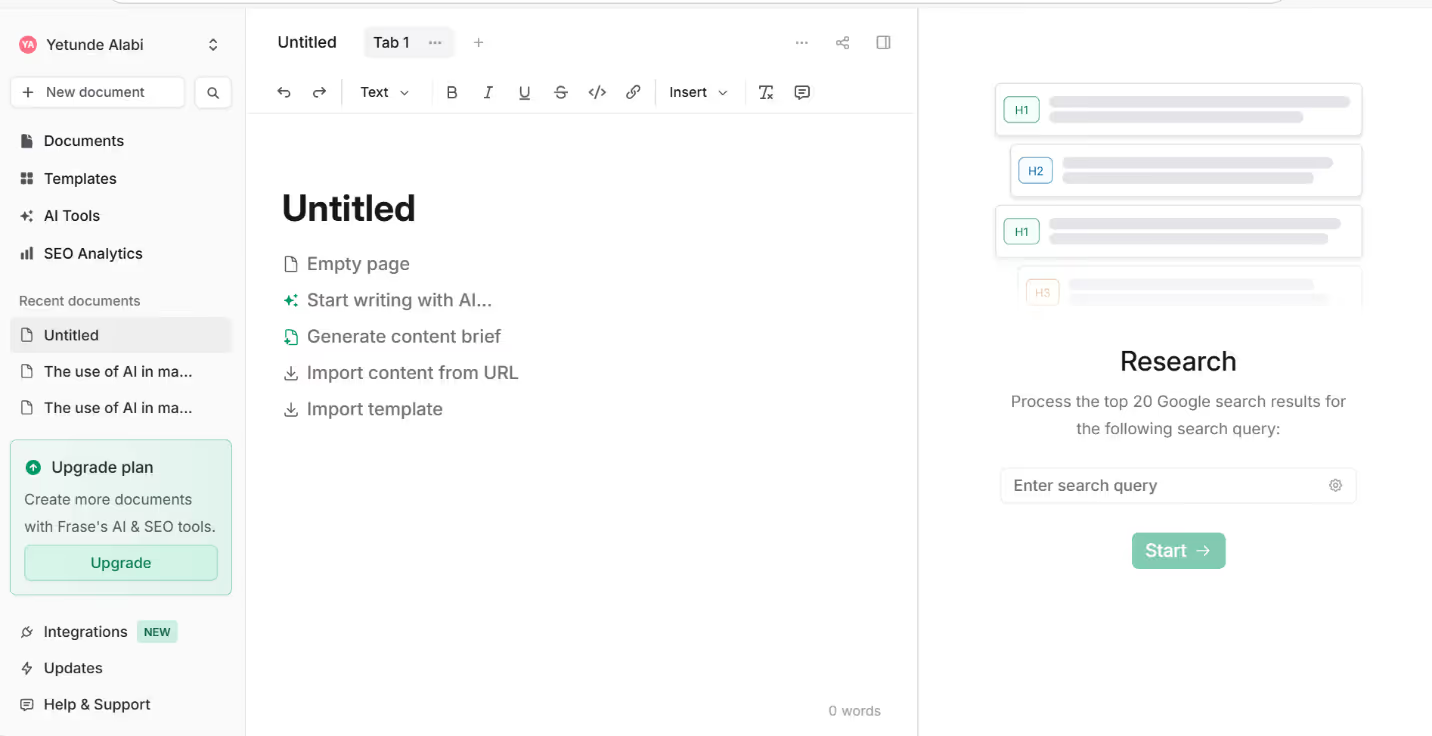
Main features:
- SEO workflow – Analyzes top-ranking pages for your chosen topic and provides a target score for SERP competitiveness.
- Content brief creation – Generates outlines you can refine into detailed briefs.
- Content analytics – Tracks performance and identifies opportunities for improvement.
- Keyword optimization – Suggests relevant keywords to improve your rankings.
When I prompted Frase to write about the use of AI in marketing, the result was fairly strong in structure and keyword placement but still needed editing to improve flow and readability.
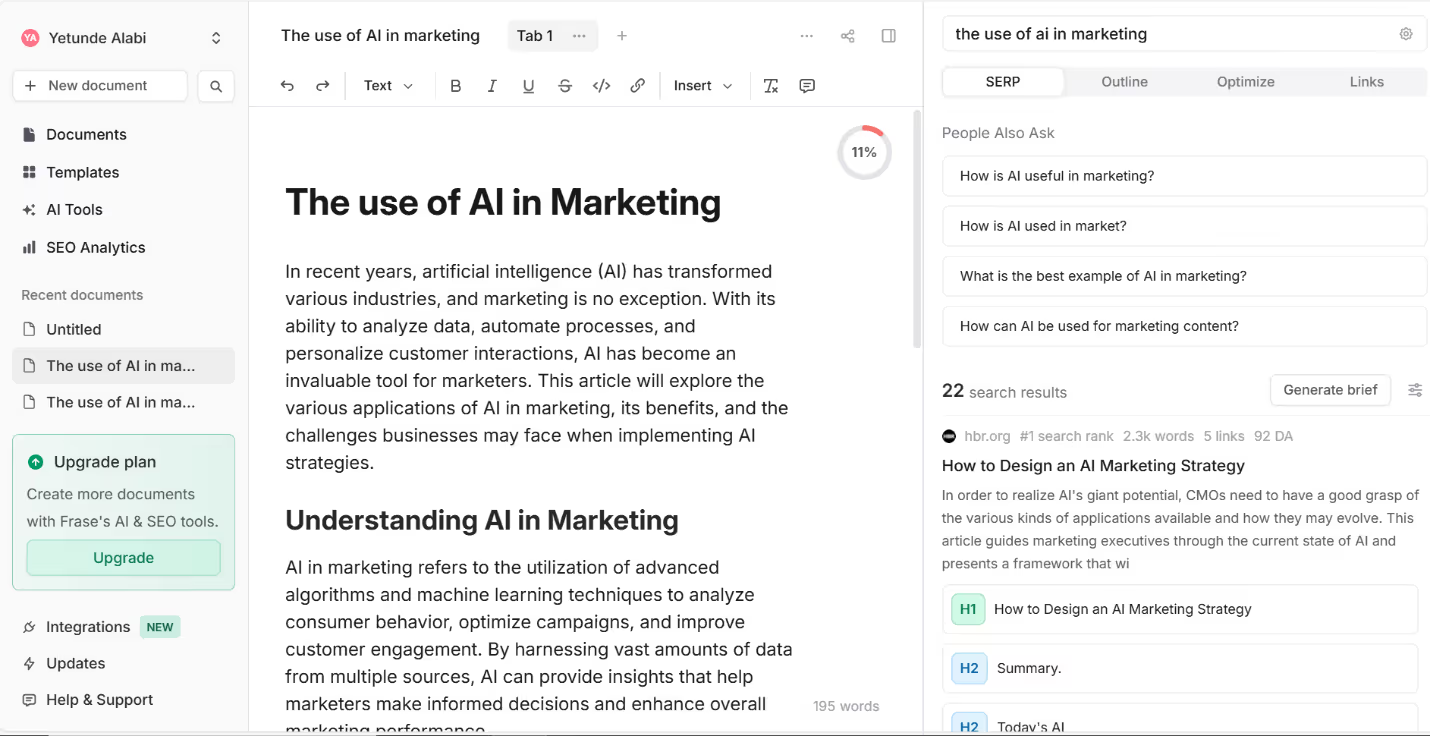
That’s something I’ve found consistent with Frase — it’s fantastic for building the right foundation for SEO, but not necessarily for producing polished, publish-ready copy without additional work.
Best for: Marketers and SEO professionals who want to build and optimize content around ranking data.
6. CopySmith
Copysmith is a Jasper alternative that shines for e-commerce marketers. It’s built to handle bulk product descriptions and integrates directly with major online store platforms, making it a strong choice if you manage large product catalogs.
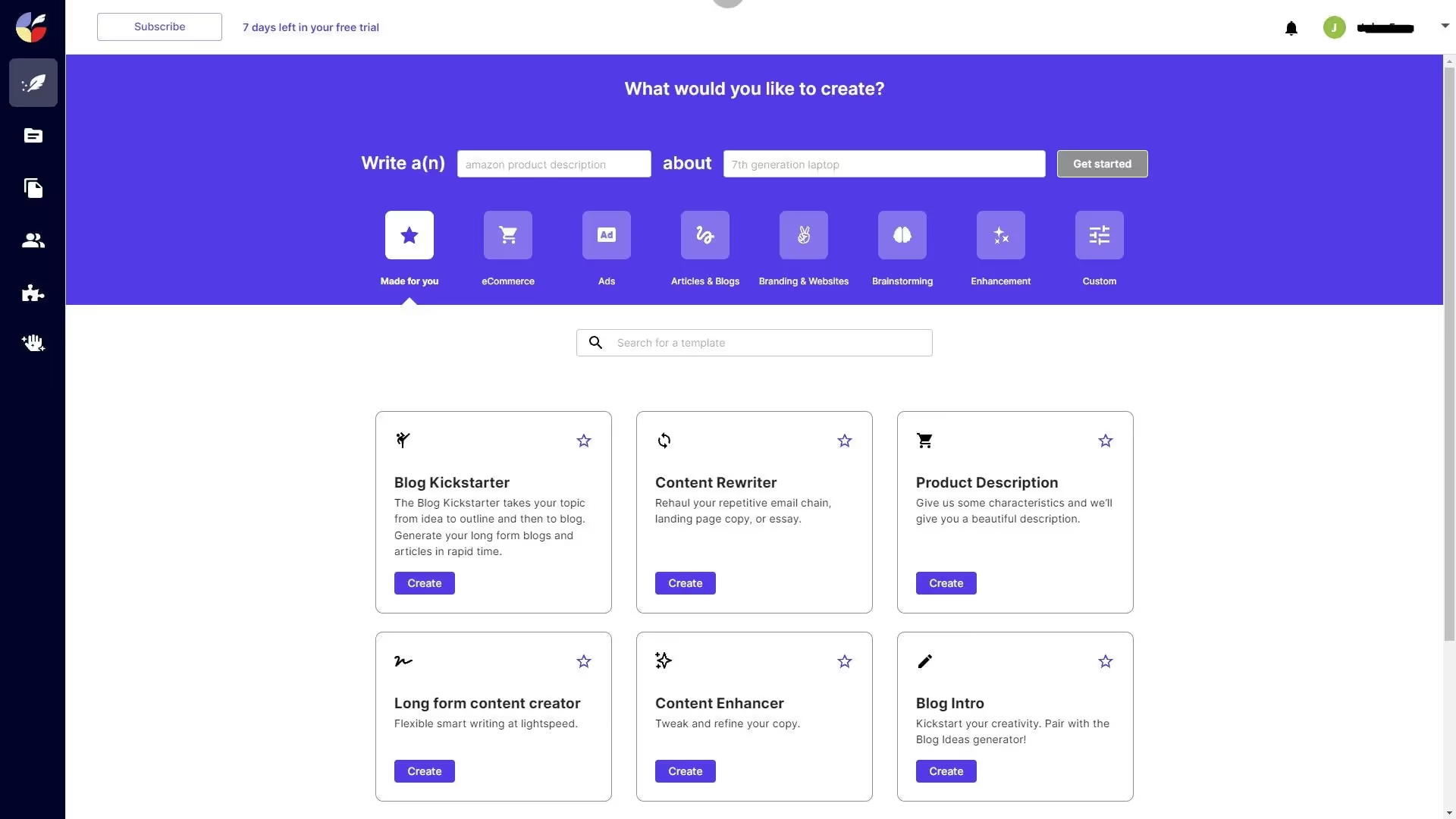
Main features:
- Bulk product description generation – Import your entire e-commerce catalog and generate descriptions at scale.
- E-commerce integrations – Connect directly with Shopify, Amazon, and WooCommerce for easy publishing.
- In-built plagiarism checker – Ensure originality before your content goes live.
- Team collaboration tools – Assign tasks, review drafts, and manage workflows in one place.
- Campaign management – Plan and organize marketing campaigns within the platform.
Copysmith does exactly what it promises for e-commerce—it makes bulk content production fast and relatively painless. The direct integrations save a lot of time compared to copying and pasting into product listings manually.
That said, its focus is narrow; if you need high-quality long-form content or thought leadership pieces, you’ll likely need a second tool.
One other downside is that unused credits expire, which can be frustrating if your workload fluctuates. Still, for online stores with frequent product updates, it’s a major time-saver.
Best for: E-commerce teams who need to produce and update large volumes of product descriptions quickly, with minimal manual uploading.
7. Quillbot
Quillbot is best known as a paraphrasing tool, but it’s evolved into a multi-purpose writing assistant with features for grammar checking, summarizing, translation, and even citation generation.
While it’s more popular among students and researchers, I’ve found some of its tools useful for marketers too, especially when you want to polish existing content rather than create from scratch.
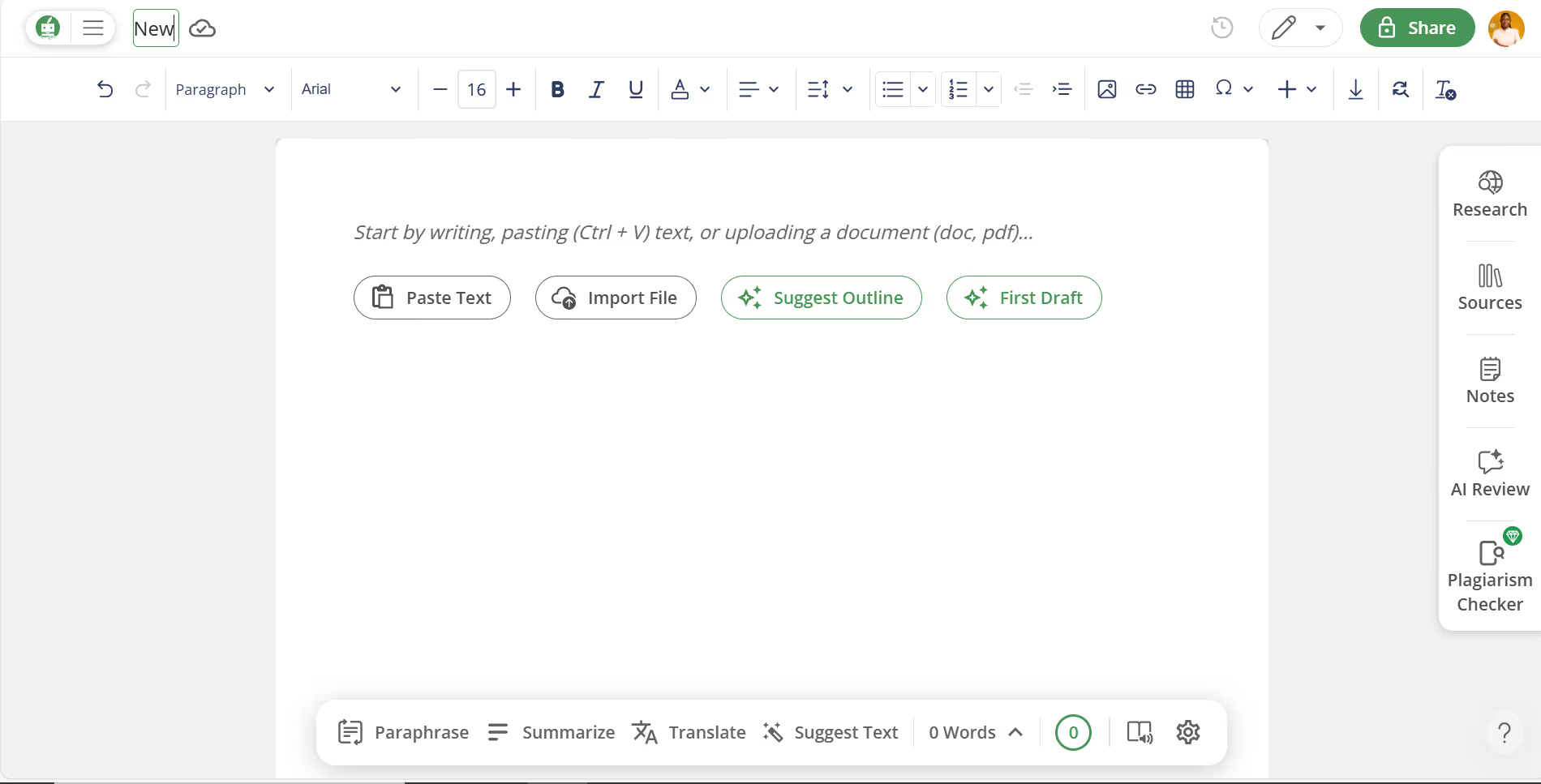
Main features:
- Paraphraser – Rewrite existing text in different styles or tones.
- Translator – Translate content into up to 30 languages.
- Citation generator – Create citations in formats like APA, MLA, and Chicago.
- Summarizer – Condense content into key points or shorter paragraphs.
- Grammar checker – Identify and fix grammar issues all at once or individually.
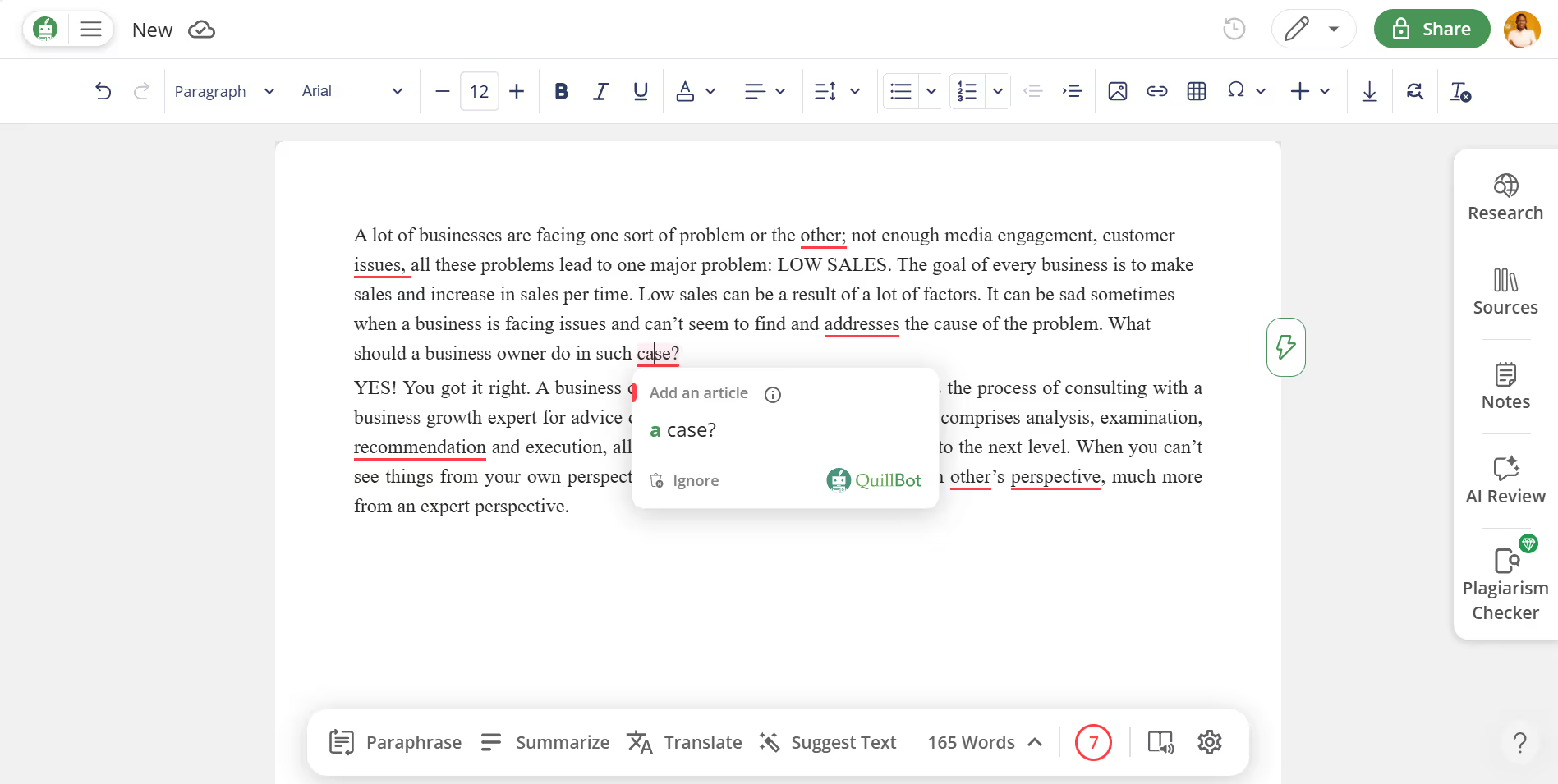
When I’ve used Quillbot for marketing content, the paraphrasing feature is particularly handy for reworking product descriptions, repurposing blog sections, or improving readability.
The caveat is that sometimes the rephrased output loses a bit of the original emotion or tone, so it’s worth double-checking before publishing.
The grammar checker is also reliable for catching small errors that slip through other tools. While it’s not a full-scale content creation platform, it’s a great companion tool for refining and adapting what you already have.
Best for: Writers, marketers, and students who need a dependable paraphraser and editing toolkit to improve existing text.
8. Anyword
Anyword is a Jasper alternative built with marketing copy performance in mind.
Its standout feature is the predictive performance score, which estimates how well your content is likely to perform before you publish it. The score updates in real time as you edit, making it easier to fine-tune ads, emails, and landing pages where every percentage point in conversion rates counts.
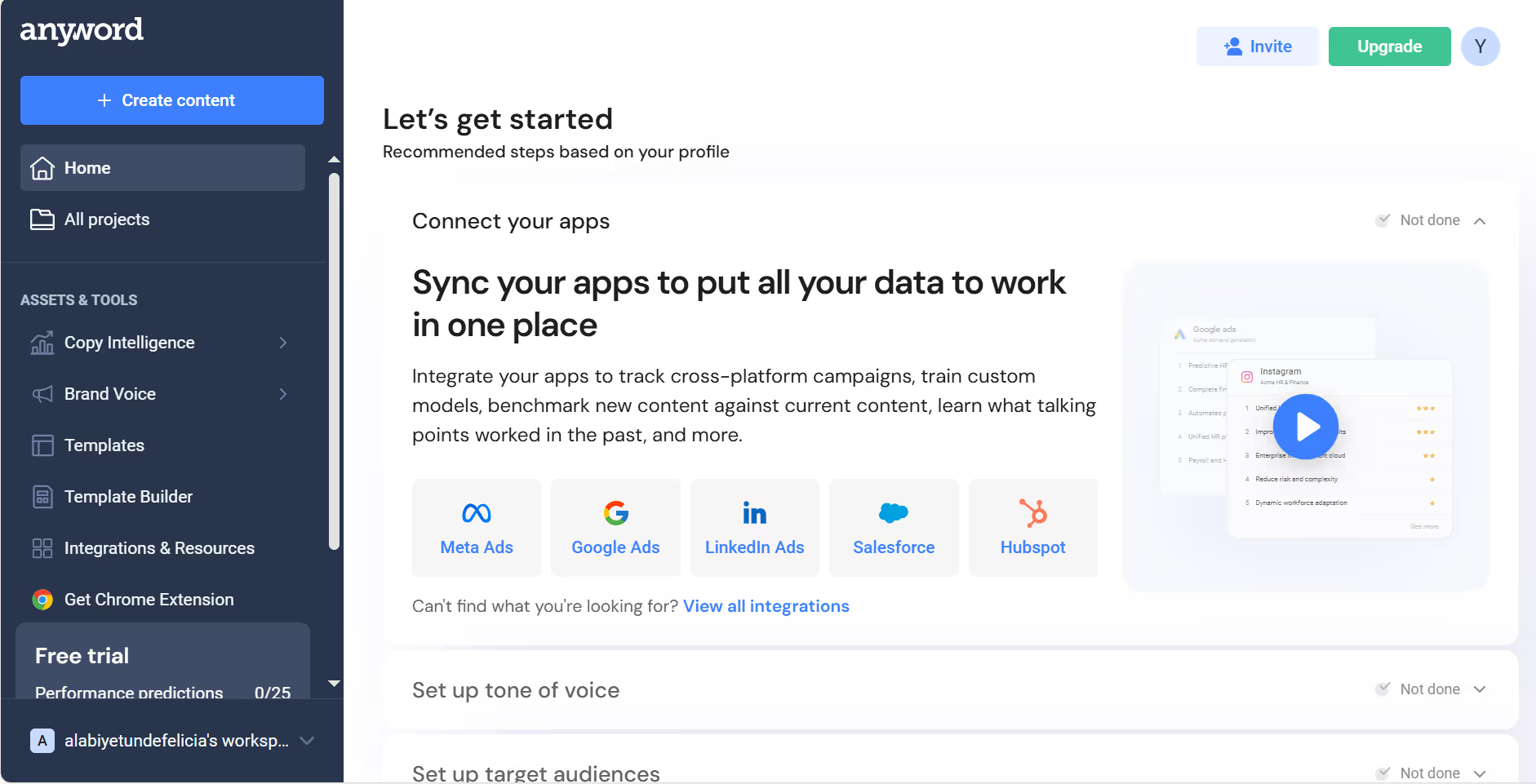
Main features:
- Templates – Multiple formats for social media posts, ad copy, and email campaigns.
- Copy Intelligence – Analyzes and scores your content for likely performance.
- Brand voice – Set and maintain a consistent tone across all your content.
- Integrations – Works with platforms like HubSpot, LinkedIn, and Instagram.
- Chrome extension – Create or optimize content directly in your browser.
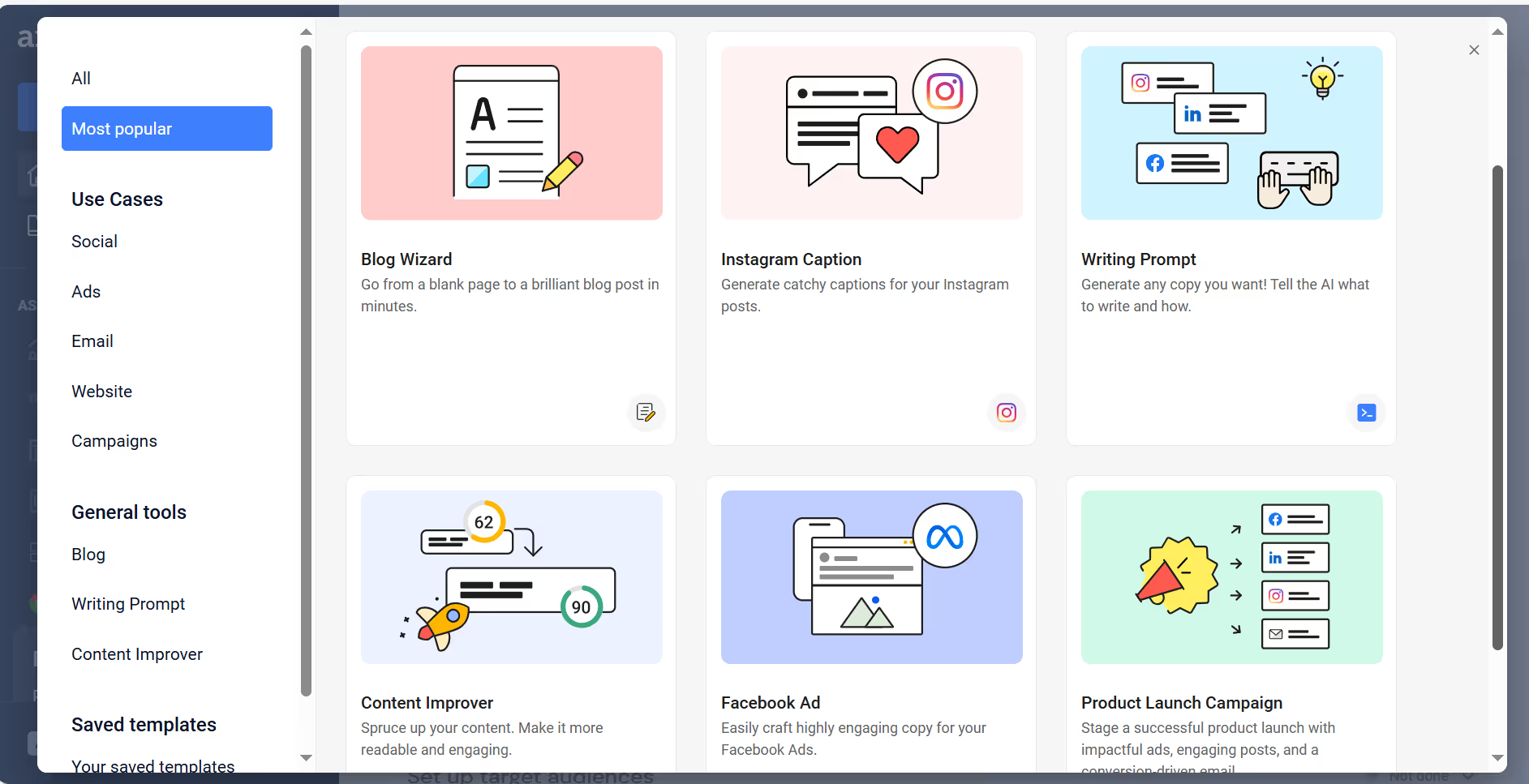
When I’ve used Anyword, the predictive performance score has been its most interesting feature. It gives you an idea of how your copy might resonate with your audience, which can help you make quick, data-informed edits before going live.
The brand voice setting is also well executed—it does a good job of keeping messaging consistent across different campaigns.
While I’ve found the generated content can still be fairly “safe” or generic in tone, the analytics and optimization tools make it a strong choice if you want measurable improvements in your marketing copy.

Best for: Marketers who want to blend AI-generated copy with data-driven performance predictions to refine ads, emails, and social content.
9. Longshot AI
Longshot AI is a Jasper alternative designed for long-form content, with a strong emphasis on factual accuracy. It’s packed with templates and workflows for different types of articles, and I’ve found it especially useful when you need more than just a surface-level blog post.
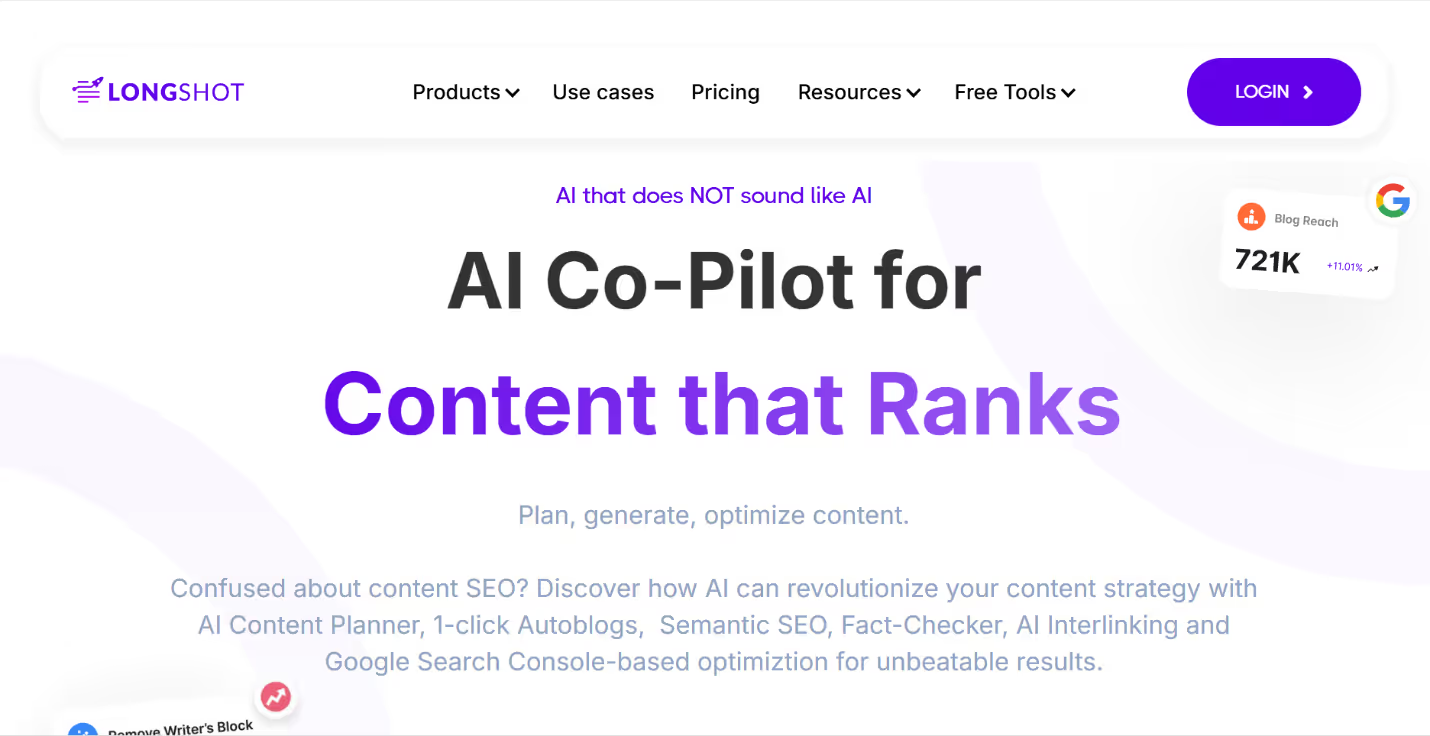
Main features:
- Fact checker – Verifies information and provides citations where possible.
- Long-form content creation – Uses popular frameworks like AIDA, PAS, and FAB to structure copy.
- SEO optimization – Tailors content to search intent and suggests keyword improvements.
- AI internal linking – Adds relevant internal links to your content automatically.
- Integrations – Works with WordPress, Webflow, Medium, Google Docs, and more.
In my testing, the fact checker is what makes Longshot stand out. While it isn’t perfect — sometimes citations can be off — it’s a step in the right direction for producing trustworthy content.

The internal linking feature is also a time-saver if you’re managing a blog with lots of articles. Its ZenoChat AI copilot and AI persona creation tools make it easy to personalize outputs for specific brands or audiences.
That said, the wide range of features means there’s a learning curve, and I had to spend some time getting familiar with the interface before using it efficiently. For projects where depth and credibility matter, though, it’s a solid option.
Best for: Content marketers who need long-form, SEO-optimized articles with fact-checking and internal linking built in.
10. Hypotenuse AI
Hypotenuse AI is a Jasper alternative built with e-commerce marketers in mind. Its features are tailored for generating product descriptions, ad copy, and other retail-focused content at scale, making it a strong fit if your main challenge is keeping product pages fresh and consistent.
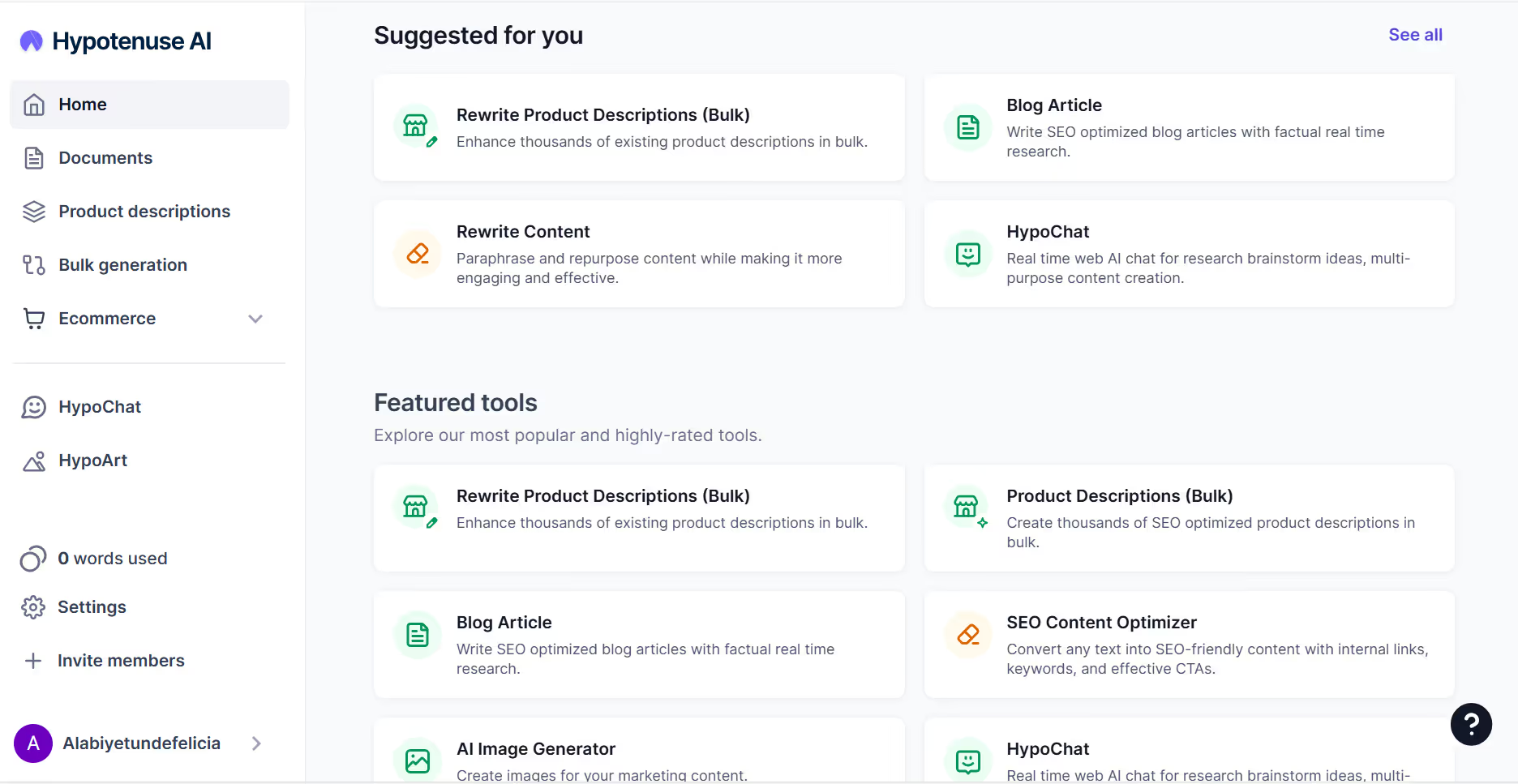
Main features:
- Bulk content generation – Create large batches of product descriptions in one go.
- Brand voice setting – Train the AI on your existing content so it mirrors your tone.
- AI image generator – Produce visuals to complement your copy.
- Product data enrichment – Fill in missing details or correct errors in product information automatically.
When I tested Hypotenuse AI, I found the product data enrichment particularly impressive—it’s quick to spot inconsistencies, like a mislabeled color, and correct them.
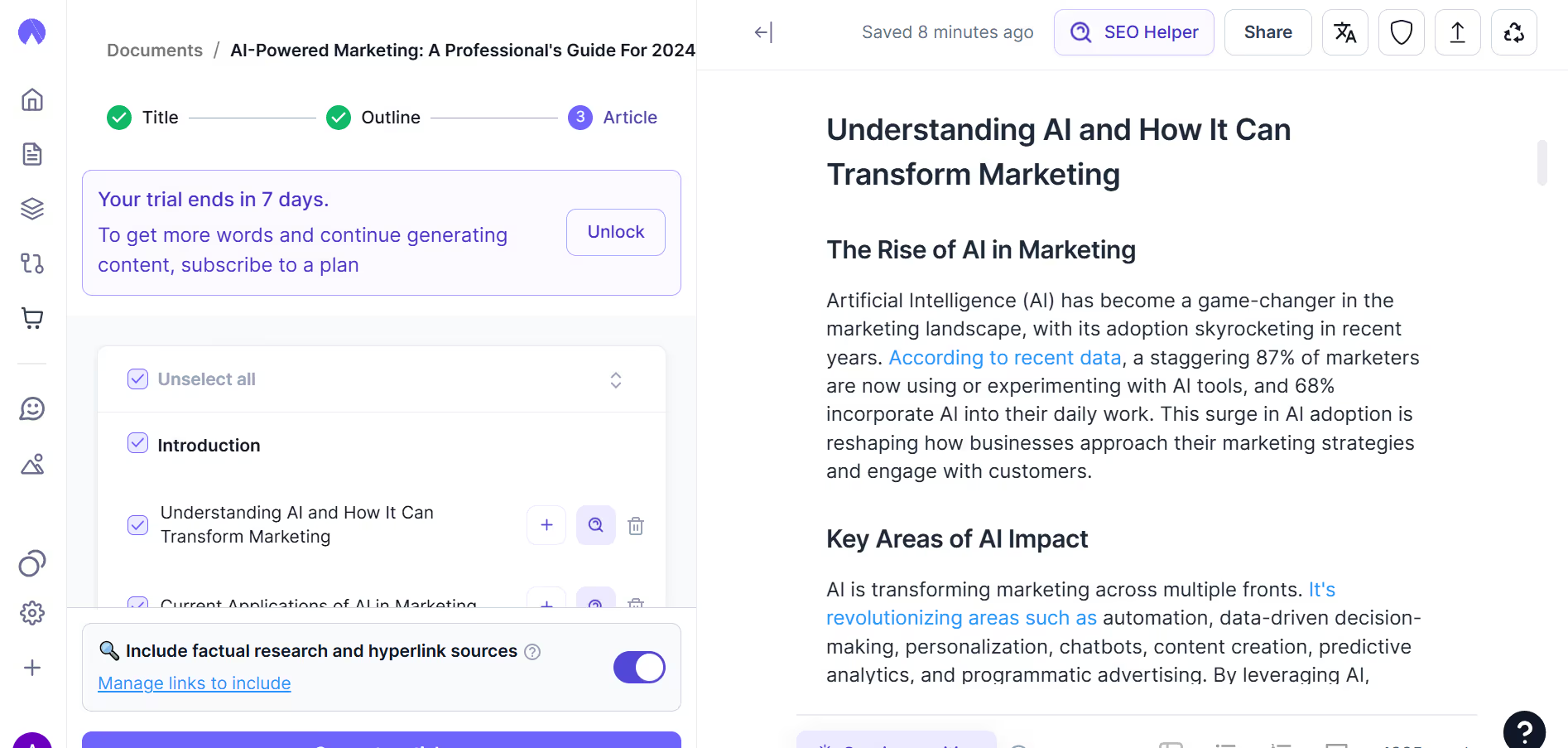
The bulk generation feature is a huge time-saver for online stores with hundreds of SKUs. While it can handle some general marketing copy, its real value is in e-commerce use cases, and it’s less versatile than tools designed for a wider range of content types.
Best for: E-commerce businesses that need accurate, on-brand product descriptions and visuals generated at scale.
11. TextCortex
TextCortex is a Jasper alternative that focuses on boosting productivity across writing, editing, and idea generation. It’s designed for a range of teams, from marketing to sales to legal, and includes features for both creating new content and refining what you already have.
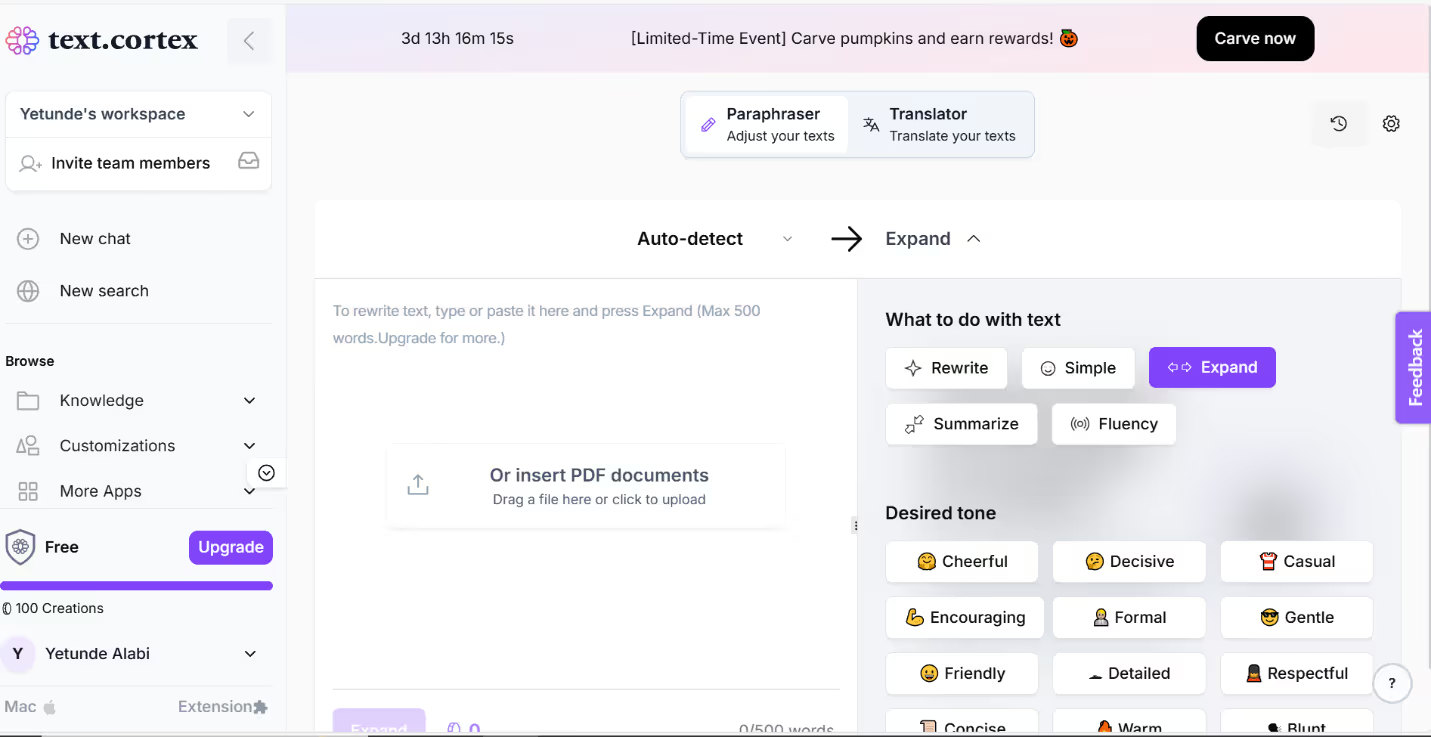
Main features:
- Document editing – Expand, summarize, simplify, rewrite, or paraphrase content.
- Grammar check – Identify and fix grammatical errors in real time.
- Templates – Over 60 options to help you start content quickly.
- Plagiarism checker – Ensure originality before publishing.
- Integrations – Works with multiple platforms and apps for smoother workflows.
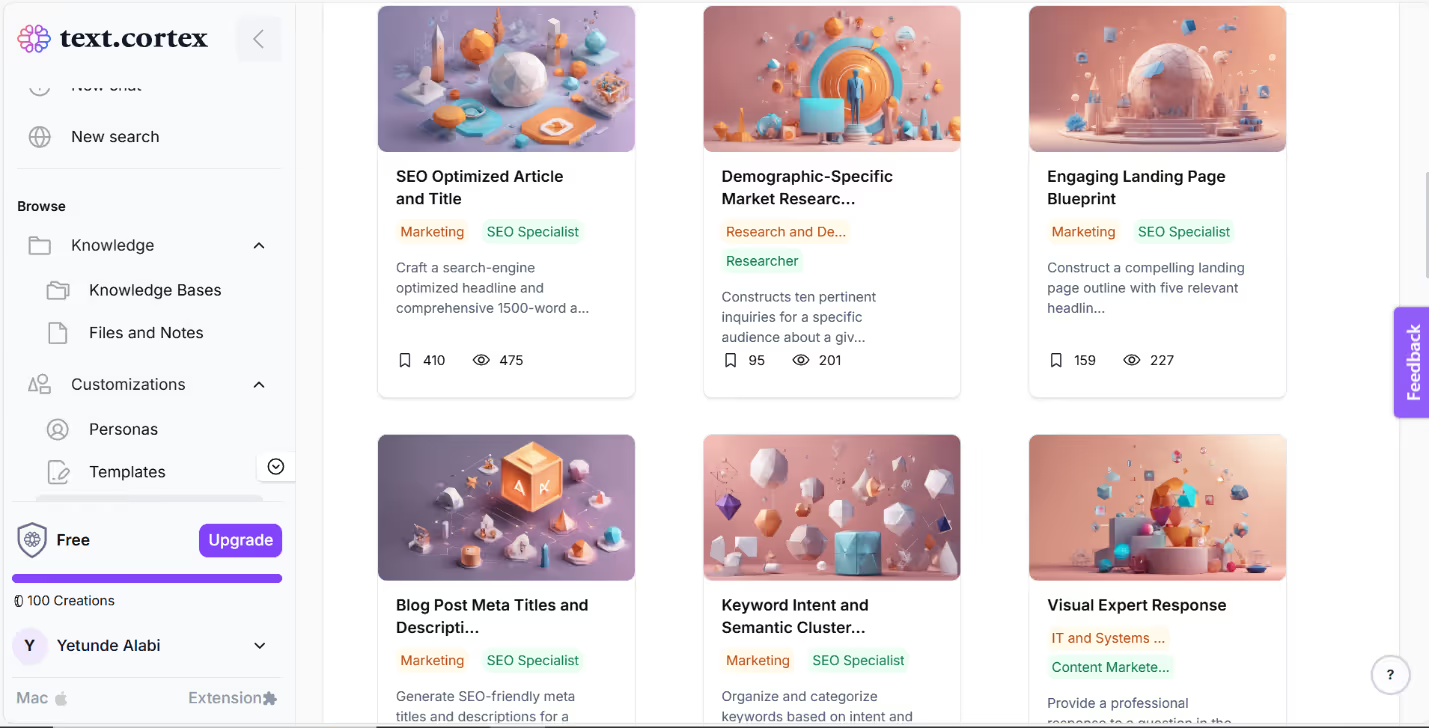
In my experience, TextCortex works well when you need to polish drafts rather than create entire pieces from scratch. The variety of editing options makes it flexible for different scenarios, whether you’re simplifying technical language or expanding a short paragraph into something more detailed.
I’ve noticed that while it can generate SEO-focused articles, the readability sometimes needs improvement, so I usually run the output through a readability checker before finalizing.
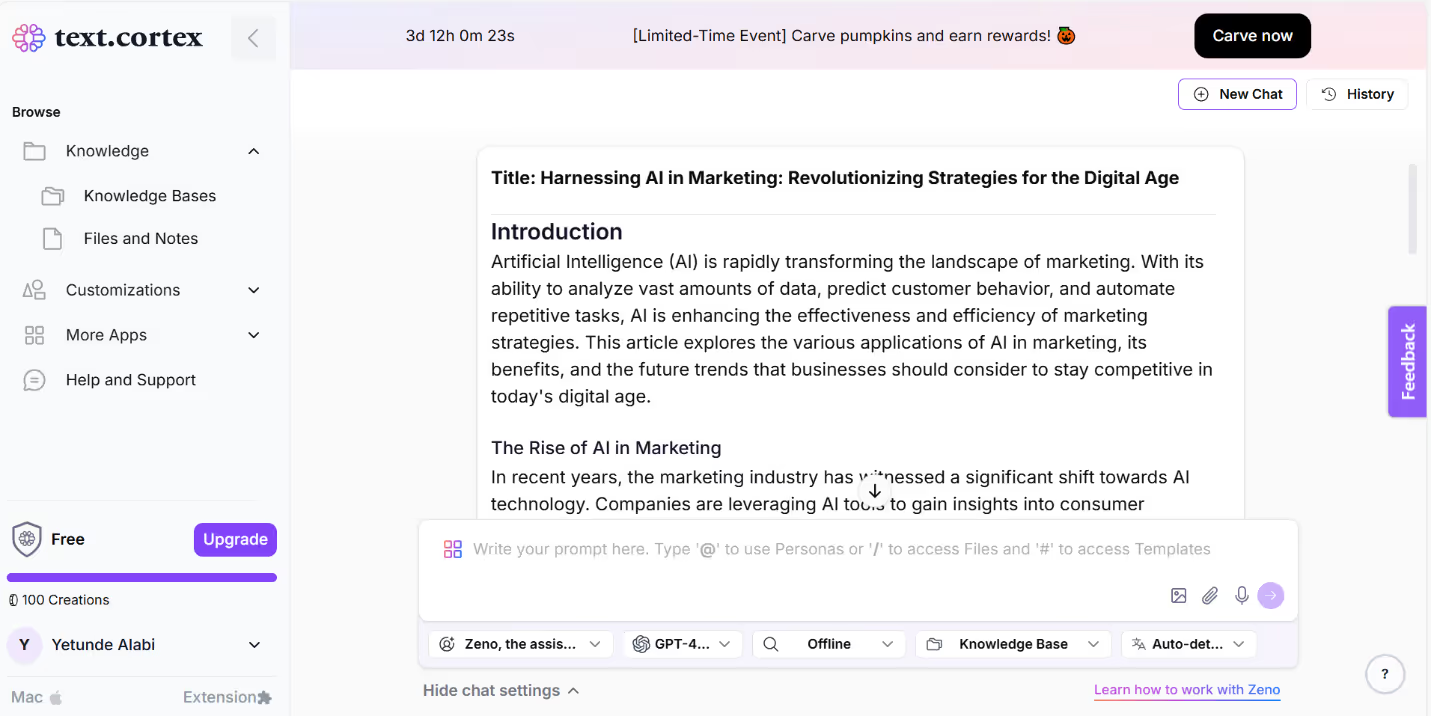
Its integrations make it easy to slot into an existing workflow, which is a plus if you’re already juggling multiple tools.
Best for: Teams and professionals who want an all-in-one editing and creation tool with strong integration options.
12. Wordtune
Wordtune is a popular AI writing tool for content marketers who want to polish their writing and a good Jasper alternative if you’re on a tight budget.
If you’re looking for a full-fledged content marketing platform that can generate a wide range of copy types, it may not be the perfect choice. Wordtune is better suited as a content polishing tool than a primary content generator.
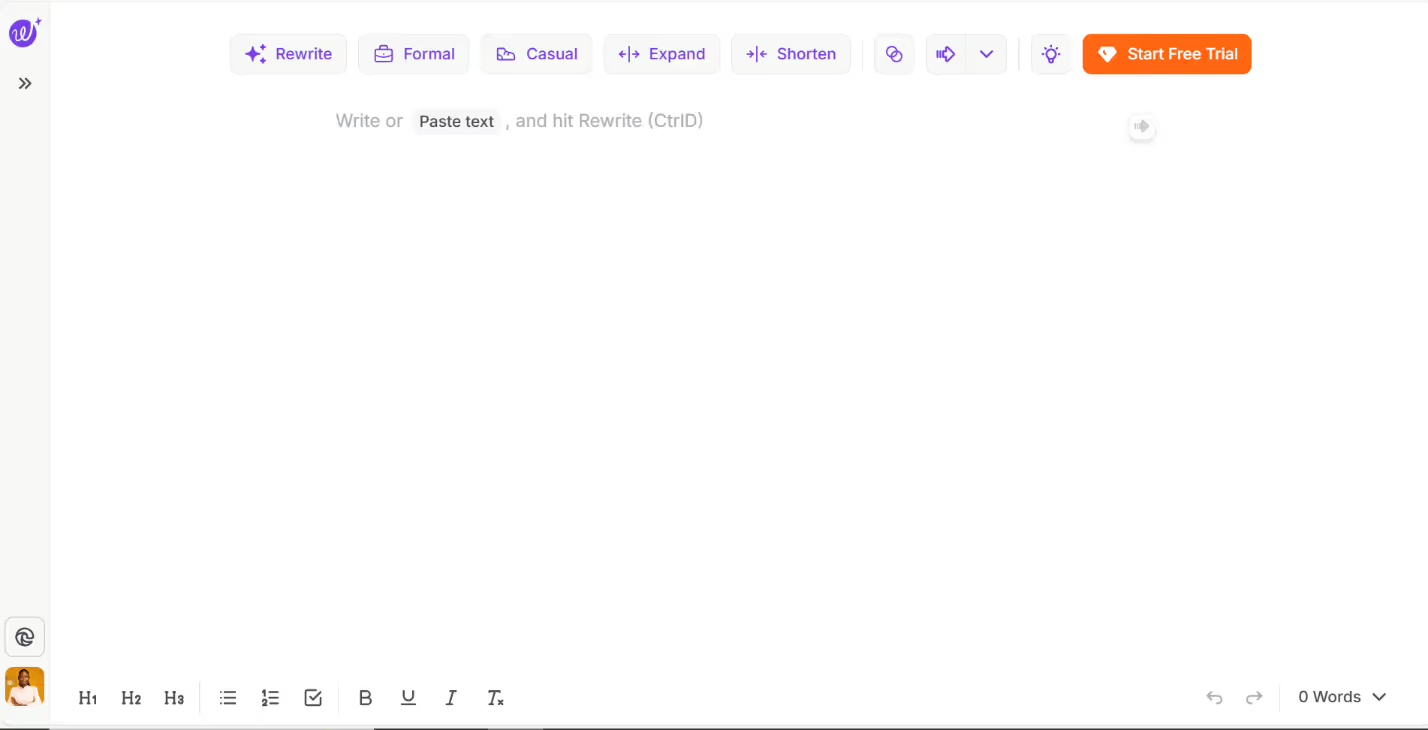
Main features:
- Rewrite – Rephrase sentences in multiple variations until you find the right fit.
- Expand and shorten – Add more detail or make content more concise as needed.
- Tone adjustment – Switch between casual and formal styles with one click.
- Grammar checks – Spot and fix errors in real time.
- Synonym suggestions – Replace repetitive words to improve flow.
I’ve found Wordtune to be most valuable for refining existing drafts rather than starting from scratch. It’s especially useful when you want to adjust tone, make sentences sharper, or repurpose content for a different platform.
While it won’t replace a full-scale AI writer, it’s a reliable companion tool for making your writing clearer, smoother, and more engaging.
Best for: Content marketers who need a simple, effective way to fine-tune tone, clarity, and structure without overcomplicating their workflow.
13. Dashword
Dashword is a Jasper alternative built with SEO-heavy content strategies in mind. It focuses on analyzing top-ranking pages for your chosen topic and guiding you on how to structure and optimize your own content to compete.
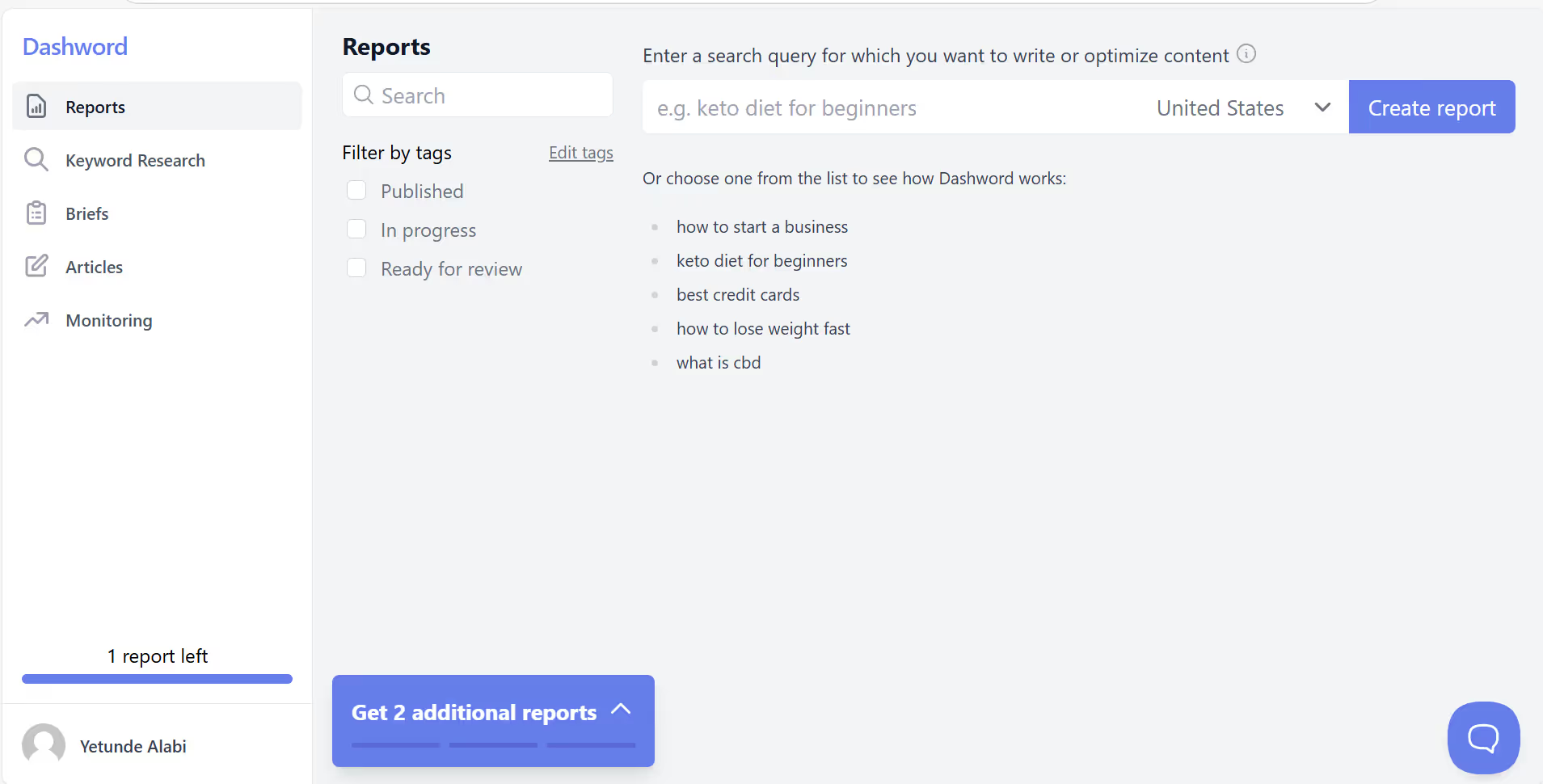
Main features:
- Content brief creation – Analyzes competitor headings and outlines to help you plan your article structure.
- Keyword optimization – Identifies important keywords to include for better rankings.
- Content performance analysis – Monitors your site to flag underperforming pages and track improvements.
- People also search for – Surfaces related keyword ideas for deeper optimization.
When I tried Dashword for an SEO-focused blog, I liked how quickly it pulled competitor outlines and keyword lists—it makes the planning stage much faster.
The optimization suggestions are also straightforward, which is helpful if you want guidance without feeling overloaded by data.
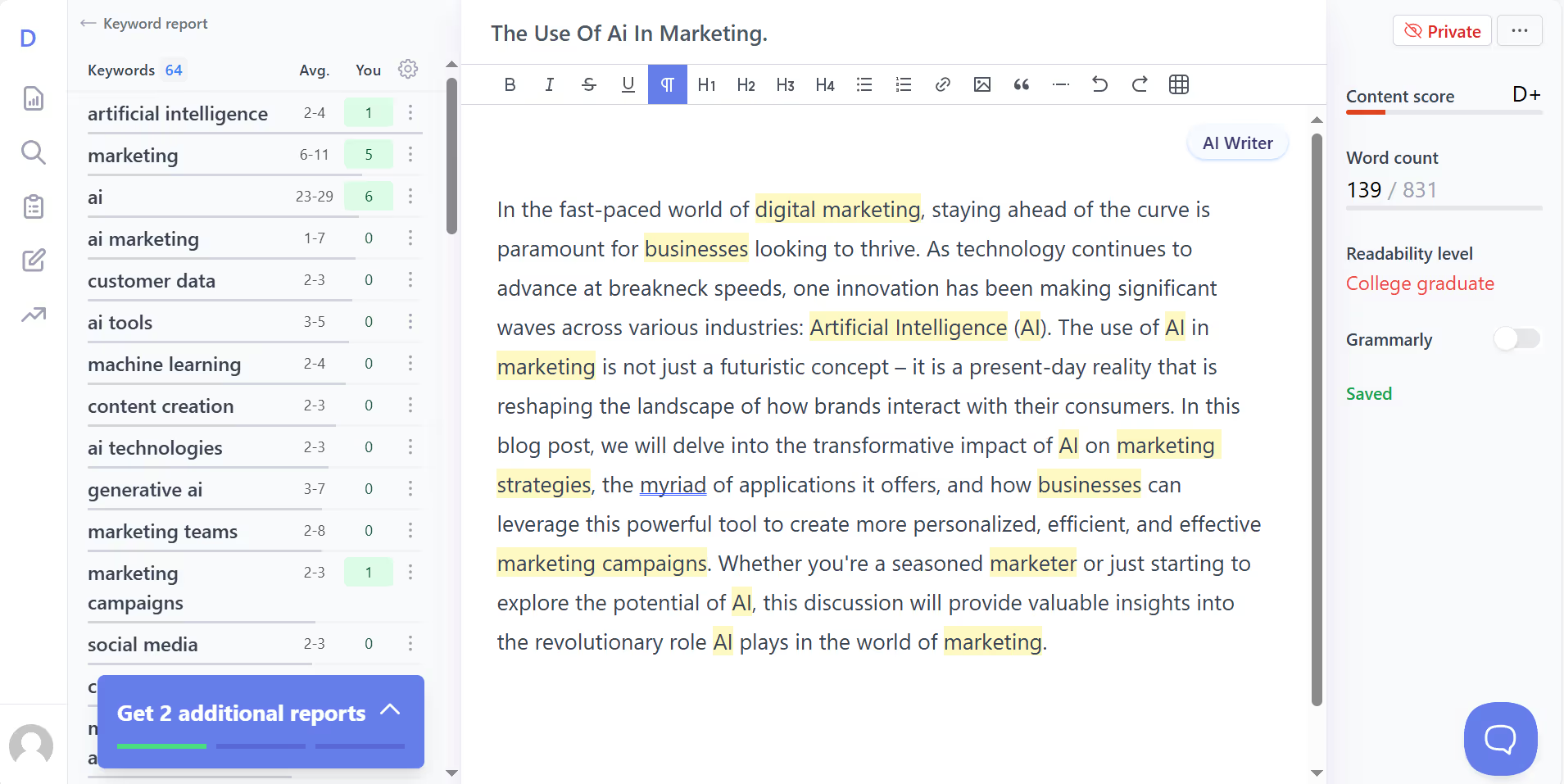
That said, it’s not meant to handle every type of marketing content, so you’ll likely still need another tool for creative copy or non-SEO projects.
Best for: Content marketers who want a streamlined way to plan, optimize, and track SEO-focused articles.
Overview of top Jasper alternatives
Choosing the right Jasper alternative
The best Jasper alternative for you depends on your specific goals, team structure, and the type of content you produce most often. If your focus is high-volume short-form copy, tools like Writesonic or Anyword may deliver the speed and format versatility you need. For SEO-driven, long-form content strategies, platforms like Surfer, Frase, or Longshot AI offer the depth and optimization capabilities to compete in search.
Consider factors like:
- Primary content formats – Are you creating blog posts, ad copy, landing pages, or all of the above?
- SEO requirements – Do you need built-in optimization guidance, keyword research, or performance tracking?
- Collaboration and integrations – Will your team benefit from shared workspaces, direct publishing, or integrations with your CMS and marketing tools?
- Budget and scalability – Does the pricing structure make sense for your publishing volume?
If you want a single platform that connects strategy, creation, optimization, and ongoing performance tracking, Surfer stands out as a strong Jasper alternative.
Its blend of AI writing, measurable SEO scoring, and long-term content performance tools make it ideal for growth-focused teams who want their content to rank—and keep ranking.


.avif)